THIRD SESSION
Dr. Herbert F. Mitchell presents a
WONDERS OF GOD'S CREATION
The Universe, the Earth, and Life on Earth
Theme: “In the beginning, God created the heavens and the earth.” Genesis 1:1.
Advanced plants and Animals
We have been examining the nature of the universe we live in, including its origins ― the origin of the universe itself
and the origin and development of the early Earth, which we looked into in the first session. Then we examined the biological cell,
which is the basis of all living things, in considerable detail in the second session. Now we are ready to examine the history and
composition of multicellular living things ― both plants and animals.
Summary of Earth’s History
In the First Session we looked at that part of Earth’s history during which either there was no life (the first thousand million
years or so) or only single-celled bacteria ― particularly cyanobacteria (those that produce the oxygen in our atmosphere)
in the next 2,500 million years or so. During that time there probably was no land permanently above the ocean surface. The Moon,
being initially much closer to Earth, exerted a pull on the oceans producing tides much stronger than now. This tidal friction
slowed the rotation rate of Earth from an initial 8-hour day to the present day of 24 hours. As the oxygen level in the atmosphere
was building up to its present level of 2l%, the formation of ozone in the upper atmosphere slowly reduced the intensity of
ultraviolet radiation until it was possible for life to exist on land. Just when land first began to rise above the ocean levels is
not known. The much stronger tides and high winds associated with the faster rotation of the earth would erode any land that appeared
during the early history of the Earth. However, the appearance of the more advanced type of cell (the eukaryote) about 2,000 million
years ago permitted multi-cellular life, first plant and then animal, to appear in the oceans.
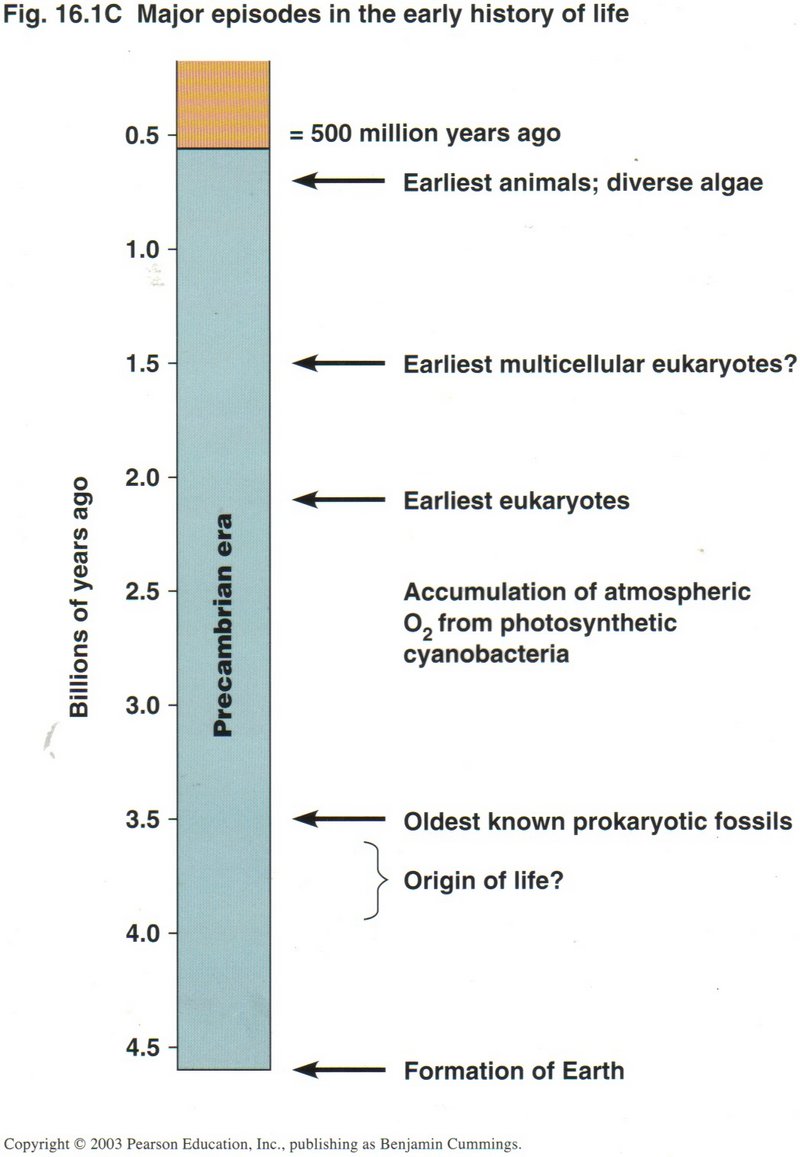
Development of Living Things
The study of life on Earth is a multi-disciplinary one, with major divisions by time (past or present) and type (animals, plants,
other). Present life can be studied as completely as desired, but past life study is limited to the remains (fossils) of such life
that have been found in many places around the Earth. When we turn to the fossil record for the earliest fossils of multicellular
organisms, we find very few examples, but some are very old. This life was in the oceans until approximately 500 million years ago.
The presence of bacteria in the oceans promised food for marine animal life. The limestones underlying today’s and yesterday’s seas
were undoubtedly formed from the shells of millions upon millions of these early marine invertebrates, who began to populate the
seas now that sunlight could provide the weather that would mix the upper waters of the oceans with the oxygen of the atmosphere,
and thus provide the means of producing the energy for animal life to digest its food and move about. The fossils of these creatures
are found in limestones dating over many millions of years. The tides were slowly lessening, due both to the slowdown in the Earth’s
rotation rate and the Moon’s moving farther from the Earth. When the Moon was much closer, the tides were far stronger than now.
Before land appeared, they were probably strong enough to cause a gigantic tidal wave to sweep over the entire Earth in the wake of
the moon’s passage above it. Hence, the surface of the sea was too turbulent for advanced forms of sea life ― whales, porpoises,
seals, and other marine mammals, and the weather for sea birds. The fossil record supports this conclusion, as mammals appear quite
late in the geological record; and sea creatures antedate land creatures.
Click here for next page.
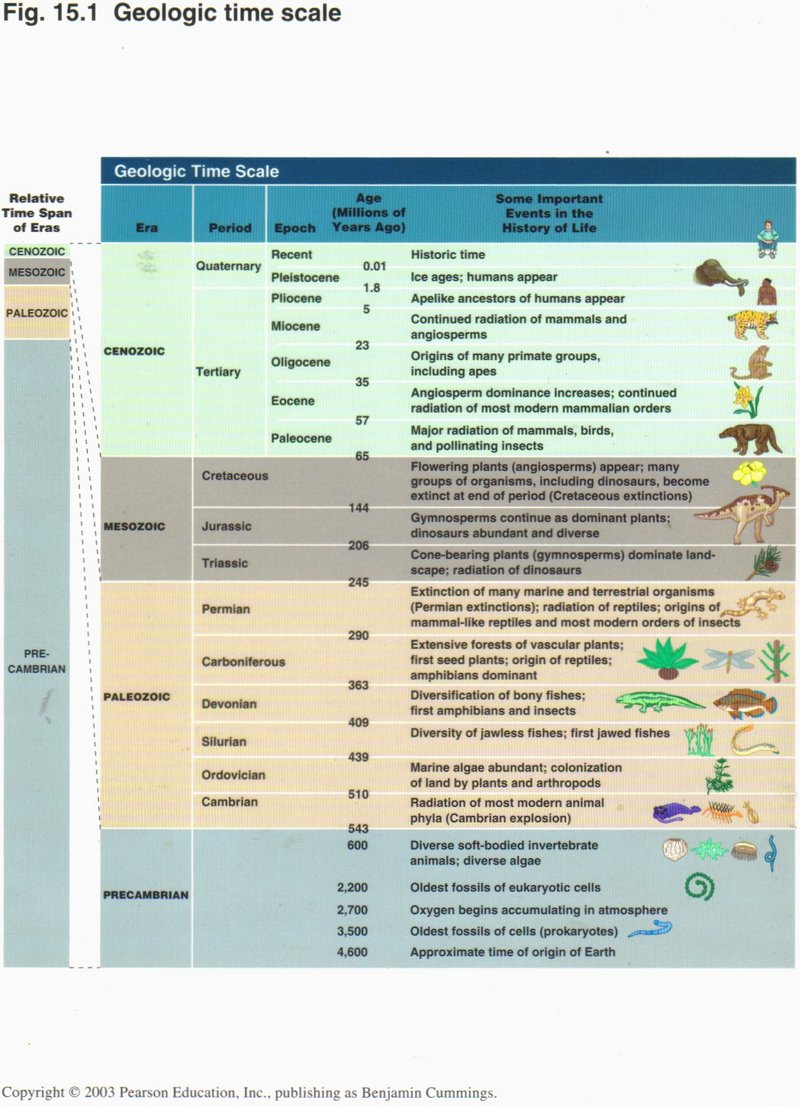 For more than 150 years geologists have been collecting, analyzing, classifying, and dating the millions of fossils ― evidence of
living things from the remote past ― that have been found all over the Earth. Time scales were sketchy at first. Then as more
precise methods of dating became available, geologic ages could be defined, and the life-forms associated with each age could be
identified. See right for chart showing the earliest life forms to appear in each geologic age. Starting at the bottom of the chart,
we see that only prokaryotic bacteria inhabited the oceans for the second and third billion years of Earth's history. They were able to
withstand the huge tidal waves that followed the moon's passage around the Earth, which very slowly diminished as the the rotation of
the Earth had slowed down, and the moon had receded from the Earth.
For more than 150 years geologists have been collecting, analyzing, classifying, and dating the millions of fossils ― evidence of
living things from the remote past ― that have been found all over the Earth. Time scales were sketchy at first. Then as more
precise methods of dating became available, geologic ages could be defined, and the life-forms associated with each age could be
identified. See right for chart showing the earliest life forms to appear in each geologic age. Starting at the bottom of the chart,
we see that only prokaryotic bacteria inhabited the oceans for the second and third billion years of Earth's history. They were able to
withstand the huge tidal waves that followed the moon's passage around the Earth, which very slowly diminished as the the rotation of
the Earth had slowed down, and the moon had receded from the Earth.
Then about two billion years ago algae appear composed of the more advanced eukaryotic cell, which permitted colonies of these more
advanced cells to begin to fill the oceans, particularly the upper levels. It took another billion years for the tidal forces that
disturbed the upper areas of the oceans to diminish sufficiently for animal life to appear in the form of soft-bodied invertebrates,
such as the crab-like trilobite, which dominated the seas for nearly 100 million years. Finally, the tides diminished sufficiently for
sea mammals and sea birds to proliferate. Hence, not until conditions allowed it does the Bible tell us that God created these
creatures, as described in Genesis 1:20-21: "Then God said, 'Let the waters abound with an abundance of living creatures, and let
birds fly above the earth across the face of the firmament of the heavens.' So God created great sea creatures and every living thing
that moves, with which the waters abounded, according to their kind, and every winged bird according to its kind."
Somewhere during the next 100 million years, the tides had diminished so that land could remain permanently above sea level, and first
plants and then amphibian animals began to populate the newly formed land masses, somewhere around 400 million years ago. From then on
the story is largely one of rapid spreading of many types of advanced plants and animals. Since animals require plants or
other animals for their food, the plants were the first to colonize the land when it became livable for them (i.e., the tides had
diminished sufficiently and the ozone layer had developed sufficiently to block excess ultraviolet light from the sun.) Genesis 1:11
anticipates this when it says: "Then God said, 'Let the earth bring forth grass, the herb that yields seed, and the fruit tree that
yields fruit according to its kind, whose seed is in itself, on the earth'; and it was so." Since this is the only place in Genesis
where the creation of plants is described, the statement is all-inclusive of plant life, including bacteria, protists and fungi, which
were probably unknown to the ancient Hebrews, as well as other multicellular plants of all types.
When plant life on Earth was sufficiently well established to support animals, many types appear. Early in this period, huge reptiles
called dinosaurs roamed the Earth. Their massive skeletons have been unearthed in many places. Suddenly, geologically speaking, they
disappear, and mammals of many diverse kinds replace them. Perhaps this is what the writer of Genesis was thinking when he wrote
Genesis 1:24: "Then God said, 'Let the earth bring forth the living creature according to its kind: cattle and creeping thing and beast
of the earth, each according to its kind.'”
The fossil record shows at least two mass extinctions of the then living things. The first was at the end of the Permian Period (250
million years ago), when many marine and terrestrial organisms became extinct, and reptiles and cone-bearing trees began to dominate
life. The second was at the end of the Cretaceous Period (65 million years ago), when dinosaurs became extinct and mammals, birds, and
pollinating insects soon abounded, and flowering plants dominated the earlier cone-bearing trees. The cause of these extinctions (and
probably numerous others) has been charged to changing climate, an ice age, or the crashing of a huge meteor into the Earth, most
probably the last named.
As land became hospitable to plants and later to animals, their remains created the vast coal and oil deposits now tapped by our
culture from all over the Earth. The fossil evidence of more than a million species of plants and animals that are no longer living
have been observed in the rocks. Some scientists believe that there have been more species of living things arise and die out, than
all of those known to occupy Earth today. The fossil record now discloses more than one million species of living things. How did
they originate and speciate into such a wide variety of life?
Click here for next page.

Modern biologists now classify life forms into five “Kingdoms”. The monera consist of bacteria (single cells with no nuclear envelope,
called prokaryote). The life forms in the other four "kingdoms" are composed the eukaryote type of cell, employing
internal membranes to isolate principal organelles ― particularly the nucleus containing the principal portion of the cell’s DNA.
Protists include amebas, slime molds, and algae. Plants can derive nourishment from inorganic materials found in the soil and include
bi-sexual flowering types. Fungi include molds, mushrooms and yeast. Animals include creatures that are bi-sexual and move about,
but cannot derive nourishment from the soil, but live by consuming plants and other animals.
Click here for next page.
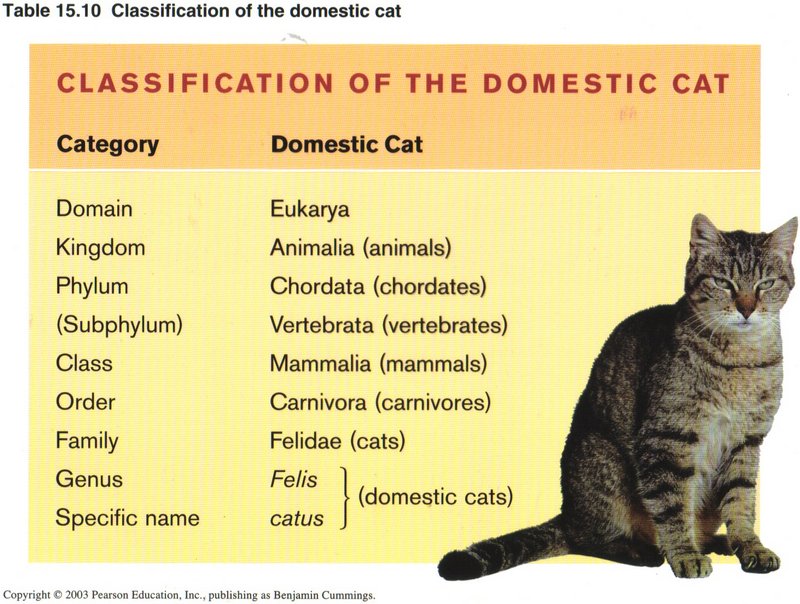
An example of a familiar animal’s classification in biology is given in this view. The domstic cat is one of the family of cats, which
are carnivores (meat eaters), have backbones (vertebrate), have gills/lungs and a nervous system (chordate), and are animals (organisms
that move, but whose food is plants and/or other animals).
Click here for next page.
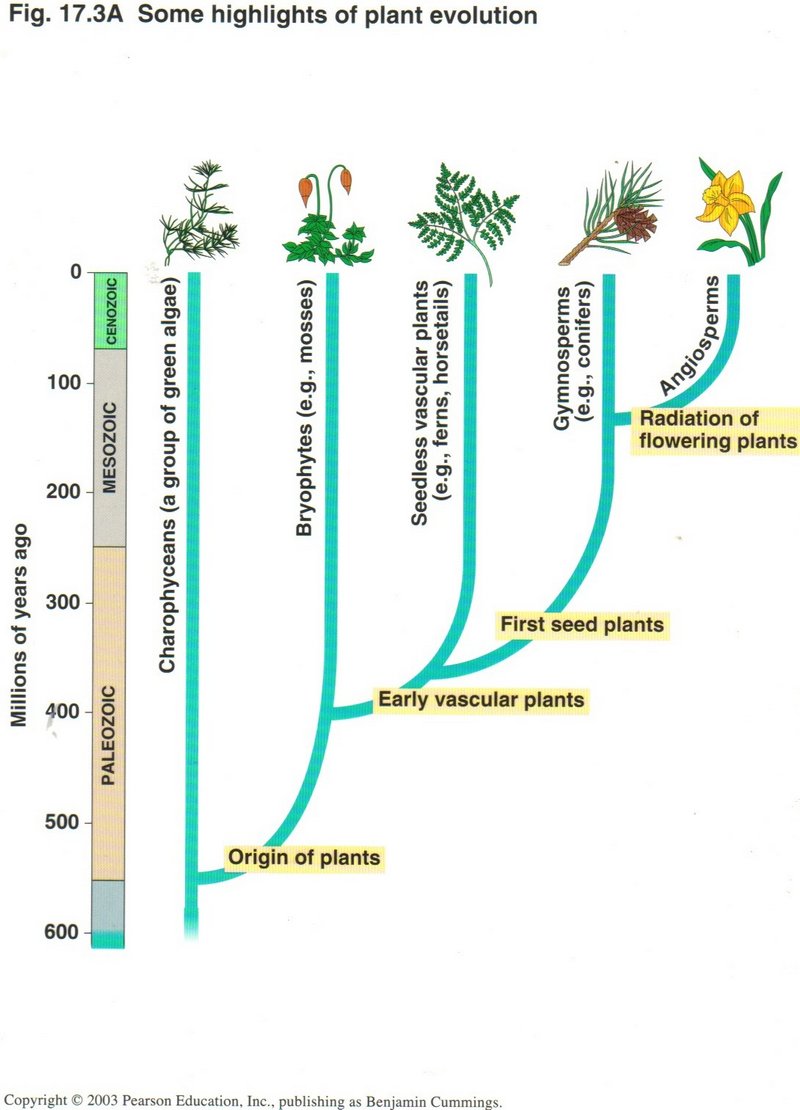
Multi-cellular plants
From the fossil record, we can see how long ago (in millions of years) the various types of multi-cellular plants first appeared on
Earth, and how biologists classify them ― algae (550), mosses (400), ferns (380), conifers (350), and flowering plants (150)
― using common plants to represent their classes. We will look at an example of each type.
Click here for next page.
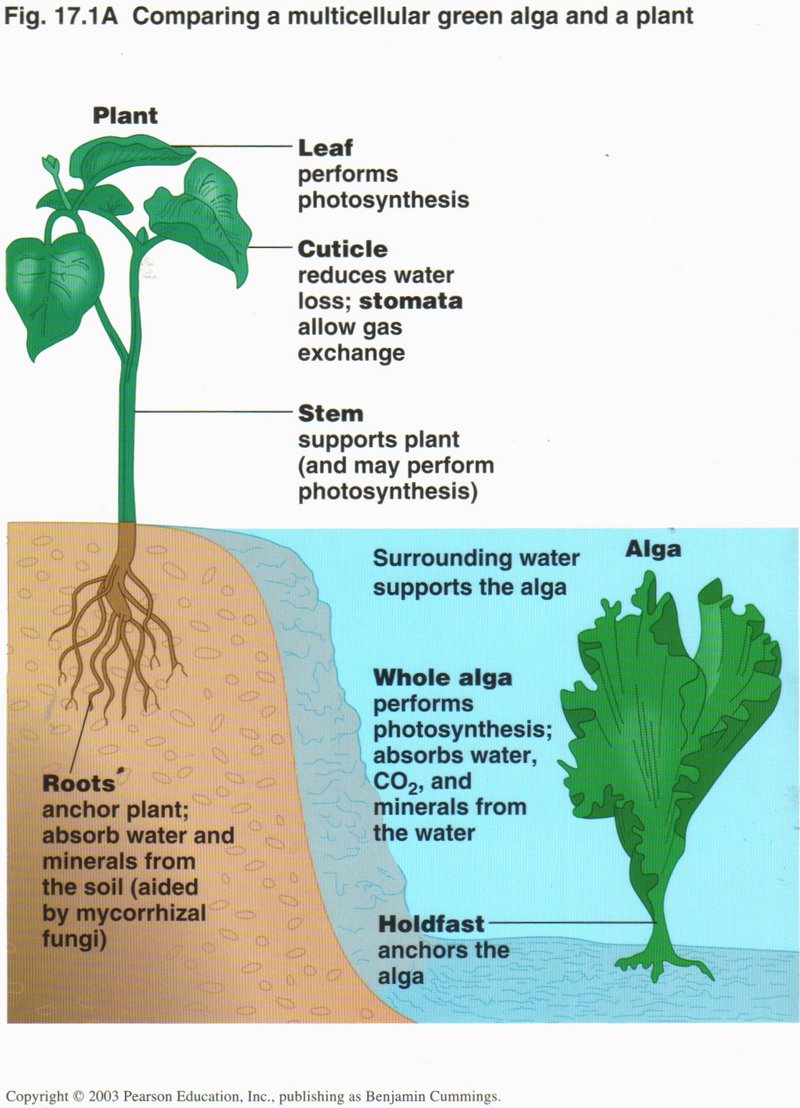
The most primitive plants, algae, belong to the kingdom of protists, as they have a much simpler structure and life cycle than
the more advanced plants. Their cells are not specialized as are those of plants and animals. The whole organism is homogeneous, and
all cells perform the same functions.
Advanced plants are sexual. They follow the same pattern of reproduction as do animals, although the details and life cycles
are much different. Animals use sex cells (gametes) solely for reproduction, with the only part of the life cycle when all of the
organism’s cells are haploid (one helix of DNA per cell) is when sperm or unfertilized egg. All plants have a part of the life cycle
in the haploid state, either as a whole plant or as pollen or seed pod. Thus they alternate between haploid and diploid (two helices
of DNA per cell) cell lives, spending as much as a year in each state. This will become more clear as we trace the life cycles of
progressively more complex plants.
Click here for next page.
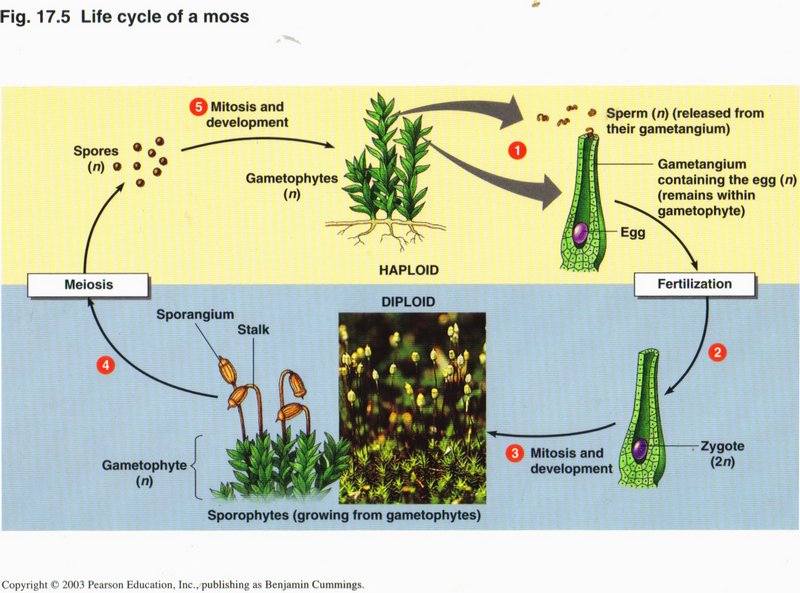
First, here is the life cycle of a moss. The major plant is haploid and so is called a gametophyte (from gamete ― a haploid cell).
The reproductive organ of the moss (its gametangium) produces both the sperm and the egg, releasing the sperm to be captured by
another moss gametangium, where it can fertilize the egg of that moss (and become a diploid zygote). The new form of the moss is
called a sporophyte, because it produces spores (haploid) through meiosis, which then proliferate by mitosis and form new
gametophytes.
Click here for next page.
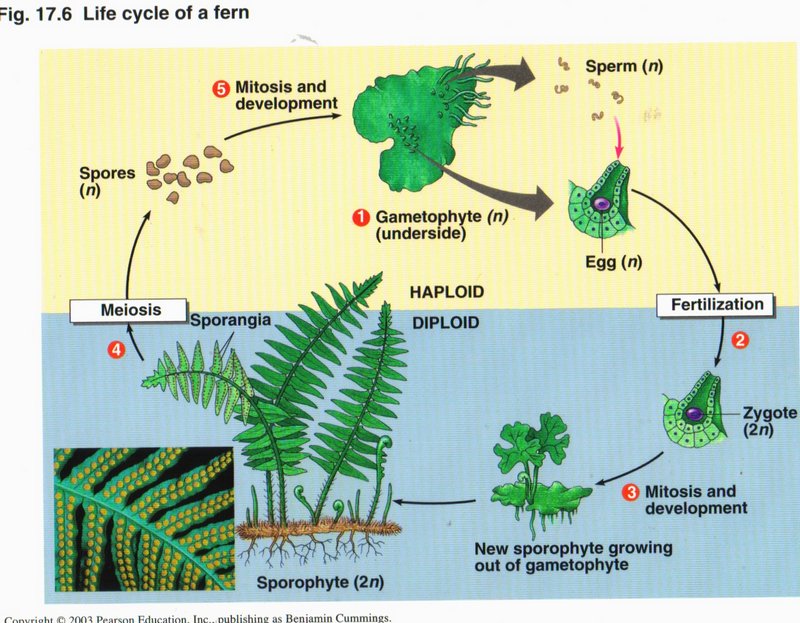
Though otherwise similar to the moss, the fern’s gametophyte form dies when the sporophyte form grows out of it. Thus there are two
separate forms of the fern, one haploid and one diploid.
Click here for next page.
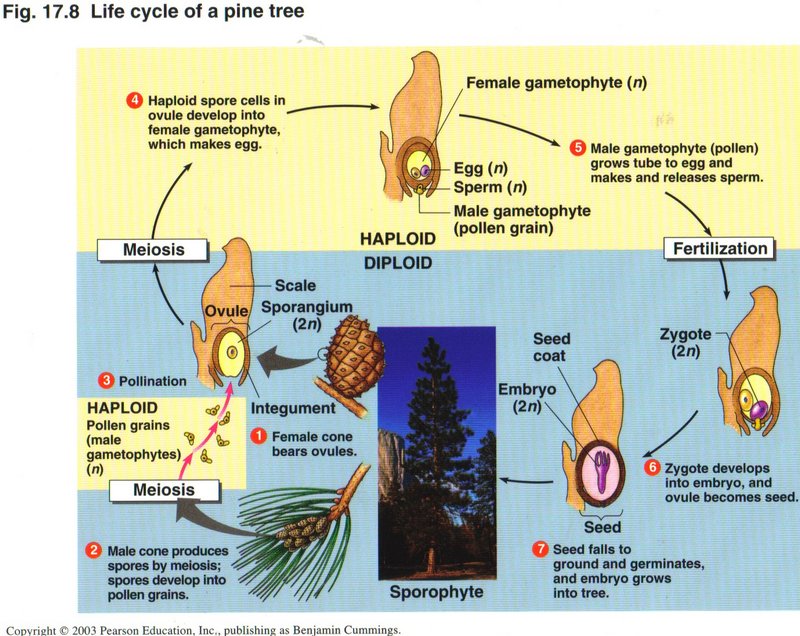
The gametophyte form of the pine tree is dual ― a female cone encloses the egg cell, and a male cone produces the pollen. When a
pollen grain penetrates the egg cell of a female cone (usually on a different tree) it will fertilize that ovum and produce a seed
(diploid) which develops into an embryo but remains dormant in the female cone (sometimes for years) until the cone falls to the
ground and opens, allowing the seed to germinate and produce a tree (sporophyte).
Click here for next page.
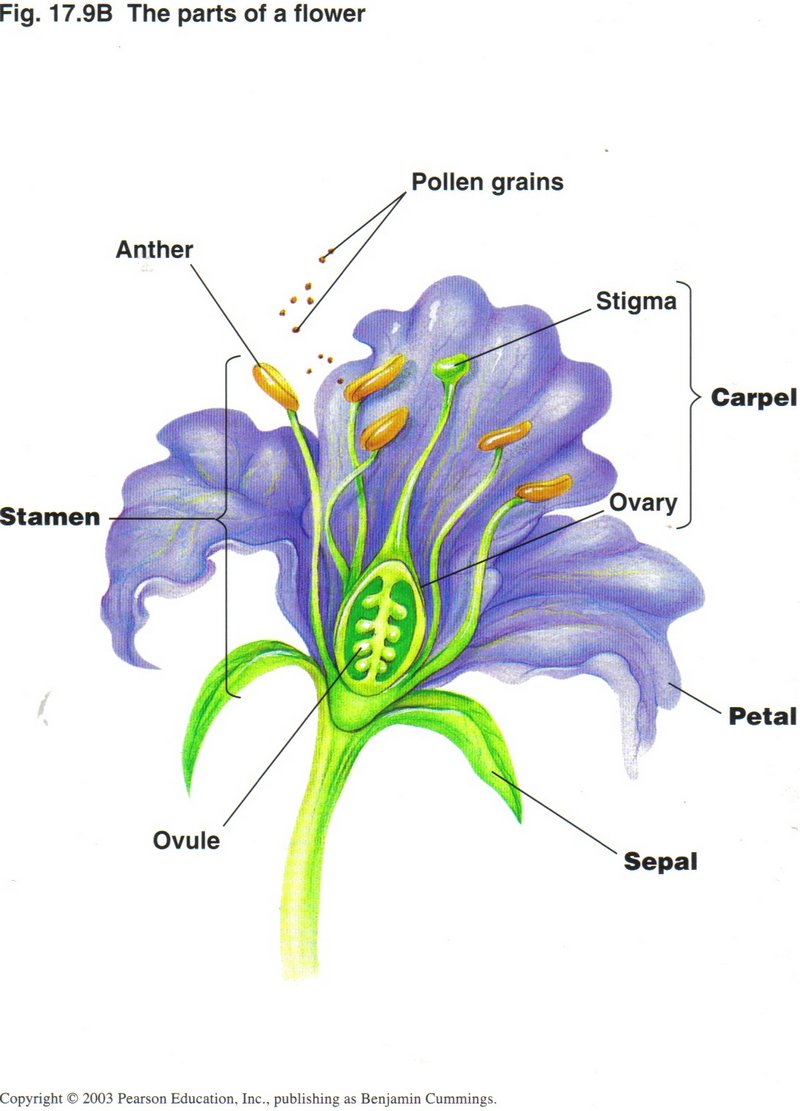
The flowering plant (angiosperm) is even more complex. Before tracing its life cycle, let us examine a flower in some detail. The
stalk produces one carpel, containing the ovary and from which rises the stem of the stigma. The stalk also produces a number of
stamens, whose tips are the anthers, which will release pollen at the appropriate time in the life cycle of the plant. Flowers often
contain nectar to attract bees and other insects that can distribute the pollen grains widely.
Click here for next page.
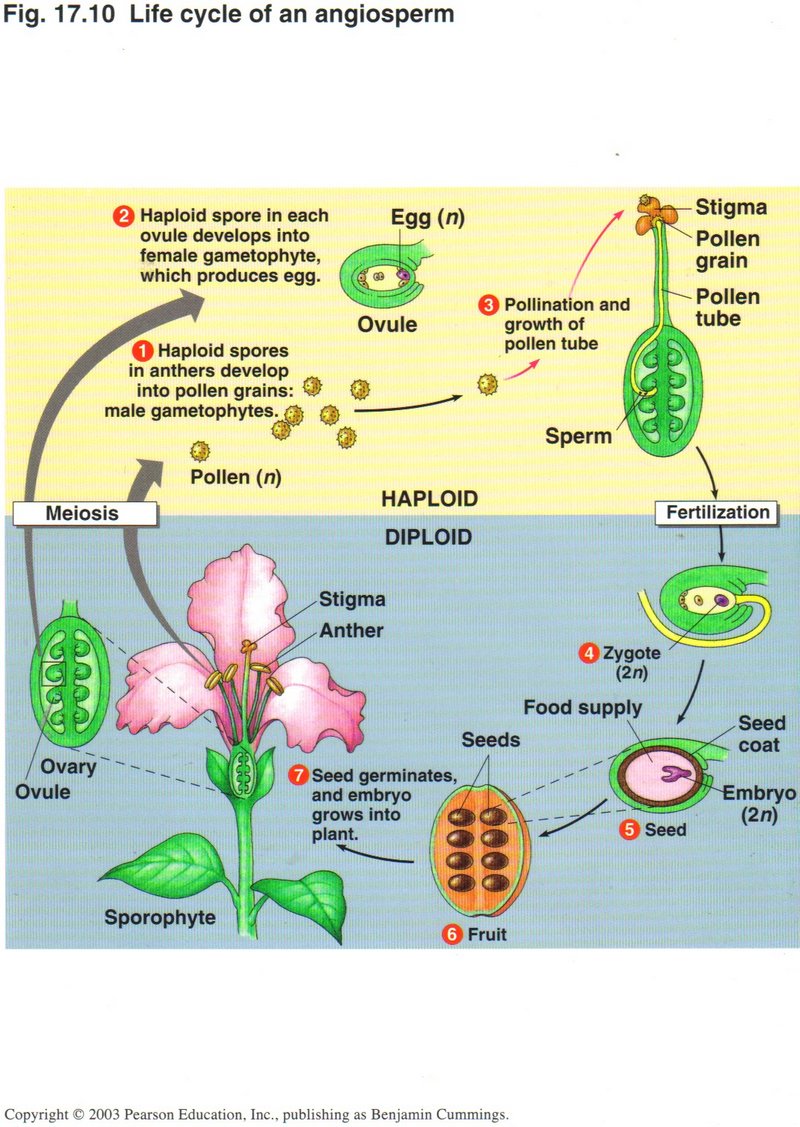
Here we see the life cycle of a flowering plant. When the time comes for reproduction, the stamens release pollen grains and the
ovary’s ovules divide by meiosis into spores which develop into eggs in the ovule. When the stigma of the carpel catches a pollen
grain, the sperm from the pollen will grow down into the ovule until it reaches an egg, which it fertilizes. The egg grows into
a seed. All ovules of the ovary may be thus fertilized, giving a multiplicity of seeds. The ovule then turns into a fruit body,
which will eventually drop off of the plant, or be removed by an animal which eats the fruit and disperses the seeds. The seeds
germinate when in a favorable environment in the ground and produce new plants.
Click here for next page.
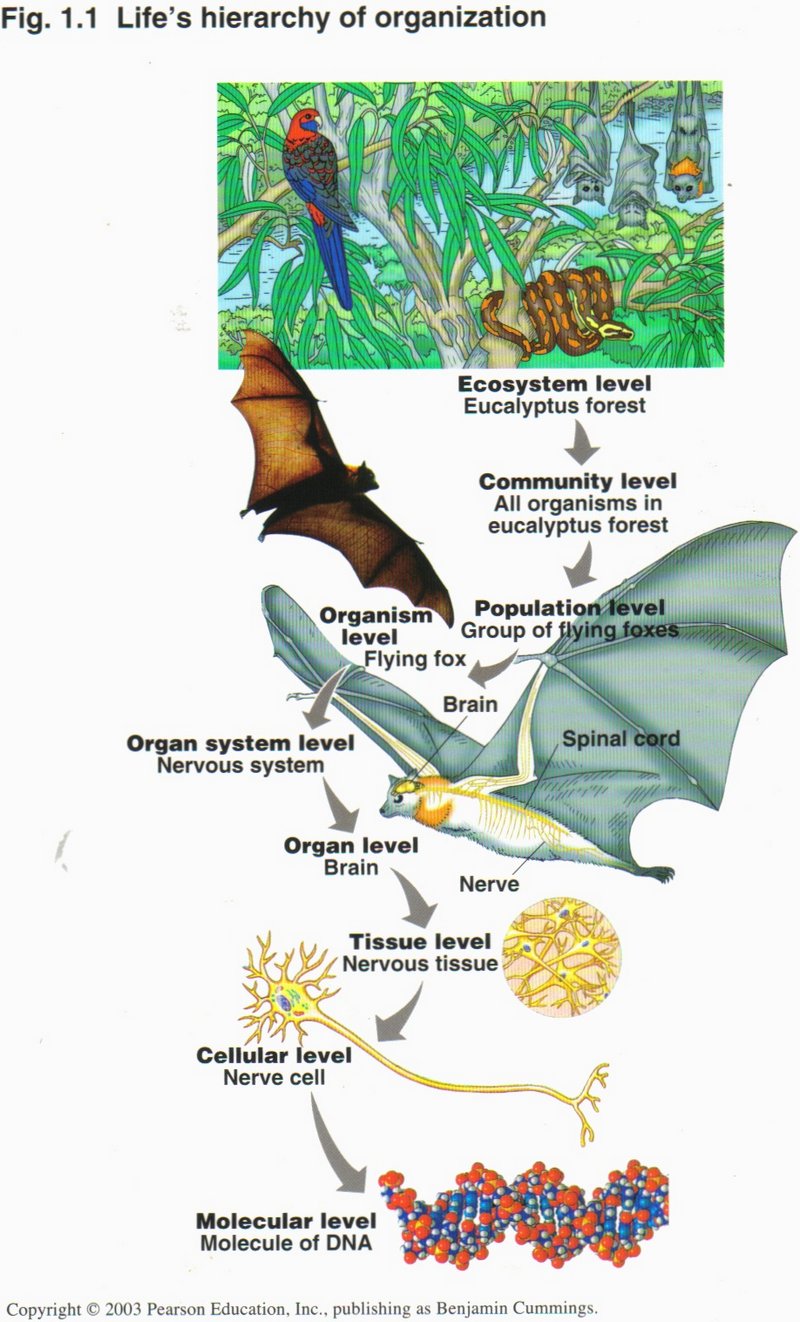
Multi-cellular Animals
We will not attempt to classify animal types as we did plants, as the basic building blocks of animals are sufficiently alike among the
various species, that a study of one (homo sapiens -- humans) will illustrate all animals. The study of living things is so broad that it has been divided into a number of scientific disciplines. These can be as specific
as the levels of life indicated on this chart, and even here the study of plants is separated from that of animals. We have already spent some
time in the molecular and cellular levels shown at the bottom of the chart, but the cells we studied were not specialized. When we
come to multi-cellular life, we find the vast majority of the cells composing that life to be specialized. An example is the nerve
cell shown at the second level. While the head of the cell is normally quite small ― in keeping with the size of unspecialized
cells, the axon can become enormously long, ― over a meter in the giant squid. We will comment on specialized cells as we briefly
consider the next higher level ― tissues.
Click here for next page.

Tissues
The first type of tissue is called epithelium, those cells which form the inner lining of various organs in the body, as shown
here. Note how the cells have a cushion-like shape, and pack themselves tightly to form a continuous surface. The shape and number of
layers of cells differ according to the requirements of the organ in which they are located ― lung, kidney, intestine, or esophagus.
Click here for next page.
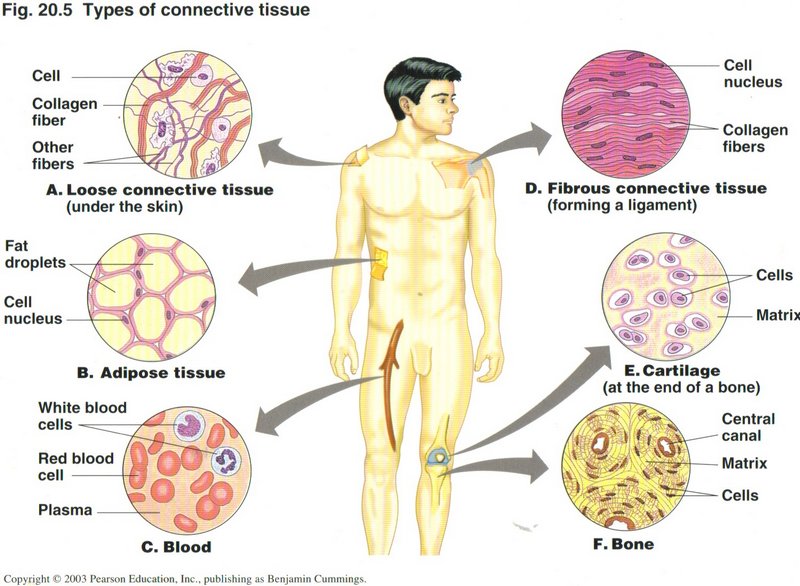
Connective tissue forms most of the structures of the body ― skin, ligaments, cartilage, or bones ― and also constitutes the
several cell types in the blood ― red and white cells, nutrients, hormones, and many other substances that are to be distributed to
the cell population. Here again, specialization is evident, according to the purpose served.
Click here for next page.
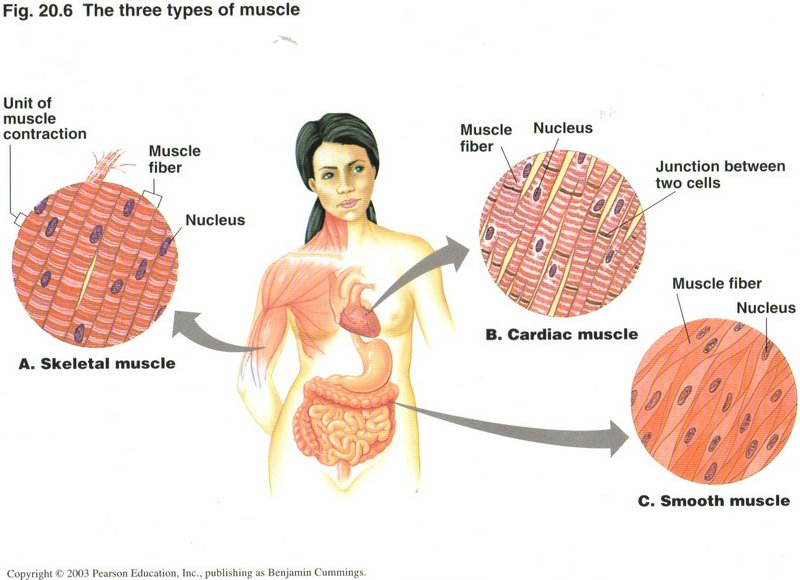
Muscles are composed of cells which have grown into long fibers, which have alternate layers of proteins within them which can
contract or relax, thus providing motion to a major element of the body. While similar in general appearance and performance, the
cells of the heart muscle, the smooth muscles of the intestines, and the skeletal muscles have different control mechanisms. Only
the skeletal muscles are under the conscious control of the organism.
Click here for next page.
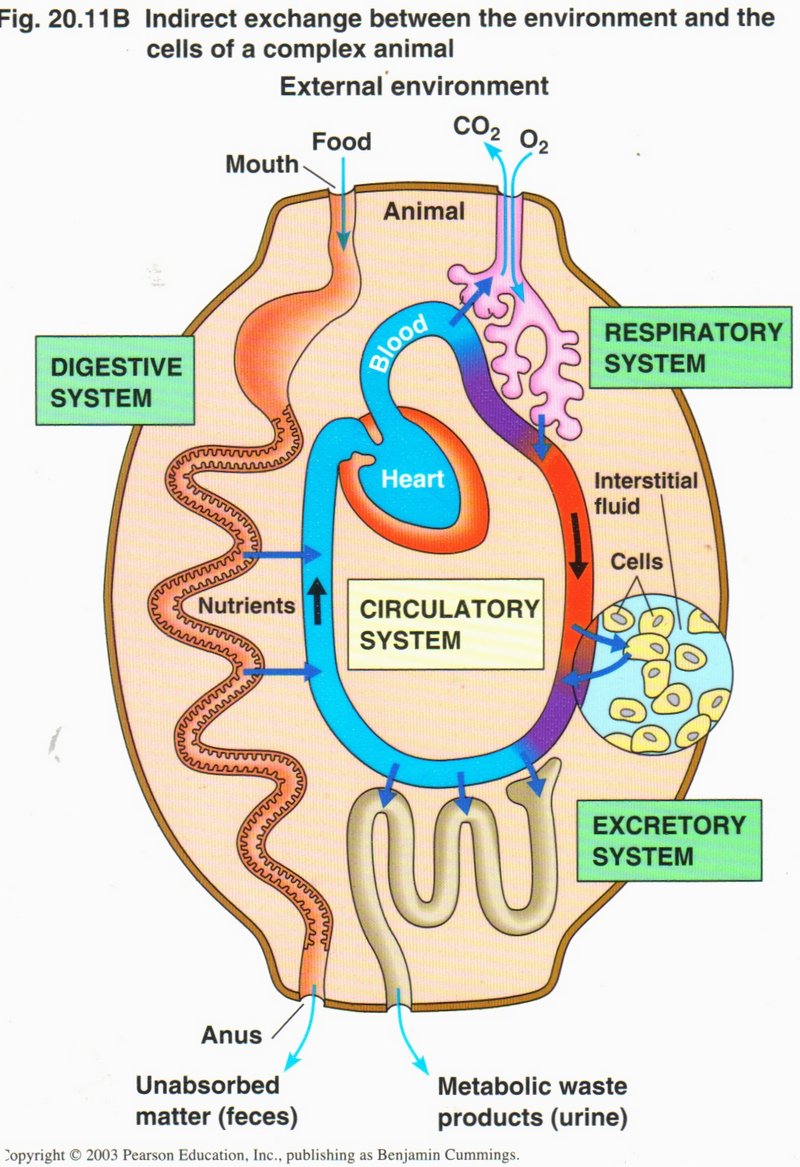
Vertebrate Organ Systems
This chart shows four of the organ systems of a complex animal: digestive, respiratory, excretory, and circulatory. It also relates
them to each other and to the environment.
Click here for next page or Click here for more detailed description.
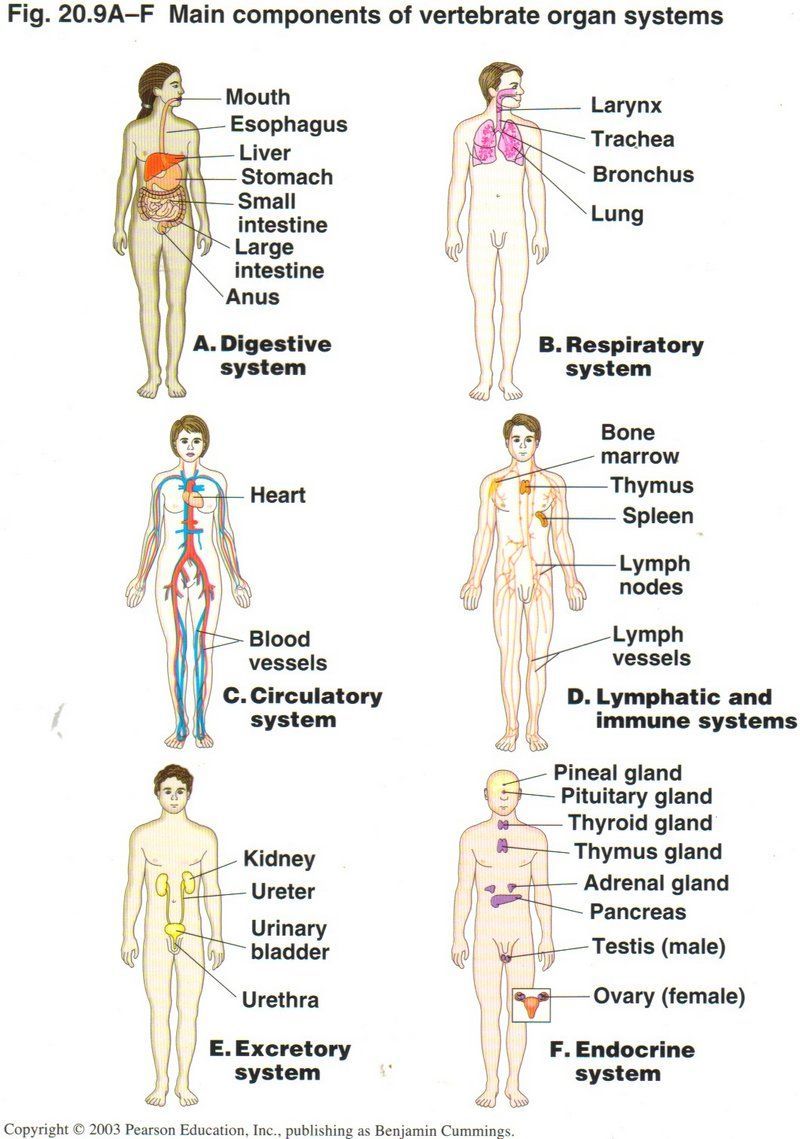
Here we see the first seven of the twelve organ systems of a human.
A. Digestive System. In this view, we see the organ pathway our food takes through the body. It starts in the mouth. There
teeth masticate the food into small pieces and saliva provides several substances that initiate digestion. The esophagus brings
the food into the stomach where pepsin and hydrochloric acid break down the long chains of proteins into smaller chains which
are further digested in the small intestine (over 20 feet long and 1 inch in diameter in humans), which receives the partly
digested food from the stomach. Here also the digestive process is completed, aided by the liver, the gall bladder and the pancreas.
The liver has many functions, and provides bile to emulsify fats. The large intestine or colon (about 5 feet long
and 2 inches in diameter in humans) serves to store undigested food and remove excess water, about 8 quarts per day, which is recycled
back into the blood and tissue fluids. Bacteria, such as E. coli, reside in the colon and produce inportant vitamins which are
absorbed into the blood stream. The terminal portion of the colon is the rectum leading to the anus at the surface of the body.
Click here for next page.

B. The Respiratory System provides the animal with molecular oxygen (O2) and disposes
of carbon dioxide (CO2). Primitive animals (such as earthworms) use the entire skin as their respiratory system, but
vertebrates use lungs (land animals) or gills (water animals). In the human, the larynx and trachea in the
throat connect with the bronchus, which in turn connects to each of the two lungs. Within the lung is a complex of folds whose
surfaces are lined with capillaries, wherein the cells discharge CO2 and absorb O2. The diaphragm is the
pump that enlarges the lung cavity to inhale fresh air and compresses it to exhale stale air. The muscles operating the diaphragm are
controlled both voluntarily and involuntarily through a sensory organ in the brain which monitors the amount of CO2 in the
blood stream.
Click here for next page.

C. The Circulatory System provides a means of bringing oxygen and nutrients to each cell of the
body and removing CO2 and waste products from the cells. The heart is the muscular organ that moves the blood through
the two-part system, containing about 65,000 miles of passages. In the pulmonary circuit, the blood flows from the heart in two
arteries to the lungs, where CO2 is discharged and O2 is acquired, thence through four veins back
to the heart. The systemic circuit serves the rest of the body. Red blood cells (humans have about 25 trillion) are unique in
structure and function, in that they have no nucleus or mitochondria, but each cell has about 250 million molecules of hemoglobin, the
protein that carries four iron atoms, each holding a molecule of oxygen during the trip from the lungs to the capillaries or a molecule
of CO2 from the capillaries to the lungs.
The heart, about the size of a doubled-up fist and weighing less than 2 pounds, is without doubt the most efficient machine ever
designed. What machine man designs can operate 20-30 times a minute steadily without pause (for maintenance or repair) for over
100 years? The amount of blood pumped by the heart in a lifetime would fill a train of tank cars 25 miles long! And this marvelous
device came abut by accidental causes? Ridiculous!
Click here for next page.

D. The Immune and Lymphatic Systems. The immune system protects the body in two ways. The non-specific defenses include the inflammatory response to invasions
of the skin, and the eating of foreign and dead self cells by phagocytes. The specific defenses are built around the lymphatic
system. The bone marrow is the source of undifferentiated cells that become B and T white cells through hormones secreted by the
thymus and spleen. These two classes of specialized cells are stored in the lymph nodes where they are available
to work on foreign cells and viruses brought to these centers by the lymph vessels, a network of tubes which serve all body tissues.
The B and T cells are programmed to recognize literally millions of different invading bodies, each cell able to recognize one such
type of invader. When the invader, in the lymph fluid brought to a lymph center, is recognized by a B or T cell, it quickly multiplies
into the thousands to provide an attack force to eradicate the invader. “Memory” B or T cells are also generated. Whereas the attack
cells last only a few weeks, the memory cells will last for years, even decades. The B cells operate on invaders in the interstitial
fluid surrounding body cells, whereas the T cells kill invaders in the blood stream or lymph fluids. In spite of all this protective
machinery the HIV virus is able to circumvent these defenses, as shown below.
Click here for next page or Click here for more information on B and T cells.
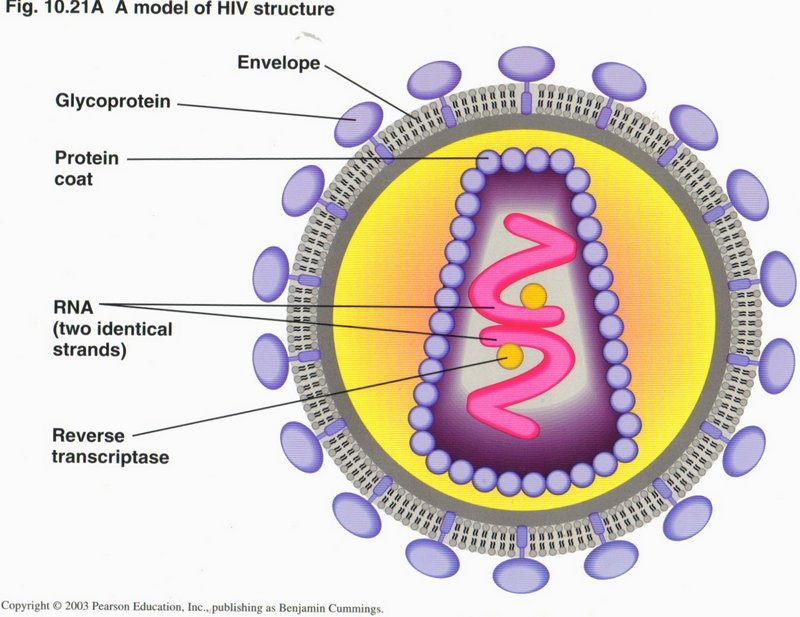

The HIV virus (see left.) The content of the virus head includes a protein called reverse transcriptase, which is capable
of making a hybrid DNA/RNA helix from the RNA of the virus and the DNA elements in the cell. When this is injected into the host cell
(see right, step 1), the injected RNA and reverse transcriptase protein complex create a hybrid RNA/DNA strand from the viral
RNA. In step 2, the hybrid strand is duplicated by the cell’s replication machinery, yielding one copy as pure DNA. In step 3, the pure
DNA copy is inserted into the DNA of the host cell, using the cell’s machinery. When activated ― perhaps many years later or never --
(step 4), this inserted viral gene generates many RNA replicas of the original viral RNA. In step 5, these RNA strands produce all
the parts of the HIV virus. In step 6, the assembled virus leaves the cell in multiple copies, destroying the cell. Since the principal
targets of the HIV are the T cells, this invader can destroy the immune system, and thereby leave the host organism (us) defenseless
against any potentially fatal disease. When we consider the contribution to destroying these defenses we make by our own wrong living,
it makes all the more likely that an intelligent Being created these defenses and allowed their breach when we humans violate proper
living practices. AIDS is an excellent example, as there is ample evidence that the spread of the AIDS virus through the civilized
world was primarily caused by promiscuous men and women, homosexuals and the needles of drug users.
Click here for next page.

E. The Excretory System disposes of waste fluids, which are drained from the blood as it passes
through the kidneys. From there the waste fluid passes through the ureters into temporary storage in the urinary bladder, from which
it is voluntarily emptied through the urethra.
Click here for next page.

F. The Endocrine System is the collection of glands (pineal, pituitary, thyroid, thymus, adrenal)
and other organs (pancreas, testis, ovary) that produce and secrete into the blood stream various hormones that regulate many
activities of the body, such as digestion, metablism, growth, reproduction, heart rate, and water balance.
Click here for next page.

G. The Reproductive Systems produce the male and female gametes (haploid cells), whose union in the female generate the zygote
(diploid cell) from which a new organism will develop. These systems also include the organs which allow fertilization to occur.
Click here for next page.

H. The Nervous System works together with the endocrine system to coordinate body activities. The brain receives information
from the sense organs (eyes, ears, nose, mouth, skin) and sends signals through the system of nerves branching out from the spinal
cord. Rather than tubes to conduct fluids, such as the circulatory and lymph systems, a nerve channel is a chain of linked axons of
nerve cells. There are millions of such signals every second, but a filtering network of neurons deep in the brain filters out all
but a few hundred, and further filtering reduces that number to the few the conscious brain is concerned with.
Click here for next page.

I. The Muscular System consists of all skeletal muscles under voluntary control, which permit movement of the various parts
of the body. Such muscles are attached to the bones or cartilage structures, and are controlled by nerve impulses. The heart muscles
and the smooth muscles of blood vessels, intestines, and the like are considered to be parts of other systems.
Click here for next page.

J. The Skeletal and Integumentary Systems. The skeletal system is the system of interconnected bones and cartilage that support
and protect the body. The integumentary system consists of the skin and its derivative hair and nails. Its major function is to protect
the internal body parts from mechanical injury, infection, excessive heat or cold, and drying out.
Click here for next page.
The amazing growth of the body from almost submicroscopic dimensions to a mature adult of whatever species, defies
complete understanding. How can an ear, for instance, multiply its size many times, but still keep the sound interpreting suborgan
unchanged? How do bones, skull and muscles grow in exact coordination from a tiny fetus to a full-sized adult? How can the literally
thousands of miles of blood and lymph vessels, joined in hundreds of thousands of junctions, provide a leak-free system of distribution
of the liquids blood or lymph? These questions can only be answered in a very general way. The exact details may never be known. But,
tell me, how could the necessary tens of millions of “accidental errors (mutations)” occur that would result in so complex an organism
as male and female humans, with every one of the 60,000,000,000,000 (60 trillion) cells in exactly the right place doing exactly the
right thing year after year after year? If this doesn’t represent intelligent design of a level so far above human mind-power that
it is lost in the stratosphere, then the author of Genesis 1 was writing nonsense when he wrote verses 26-27: Then God said, “Let us
make man in Our image, according to Our likeness; let them have dominion over the fish of the sea, over the birds of the air, and over
the cattle, over all the earth and over every creeping thing that creeps on earth.” So God created man in His own image..
Click here for next page.
Origin of Man
All families of animals were in existence or appeared by the Paleocene Epoch, 65 million years ago, with mammals the last to appear.
While changes have occurred in these animals over the last 65 million years, their basic organization has not. The ice ages of the
last million years were the backdrop for human-like creatures and our own species, homo sapiens, for which the origination date is
variously placed at 100,000-plus to 40,000 years ago.
Click here for next page.
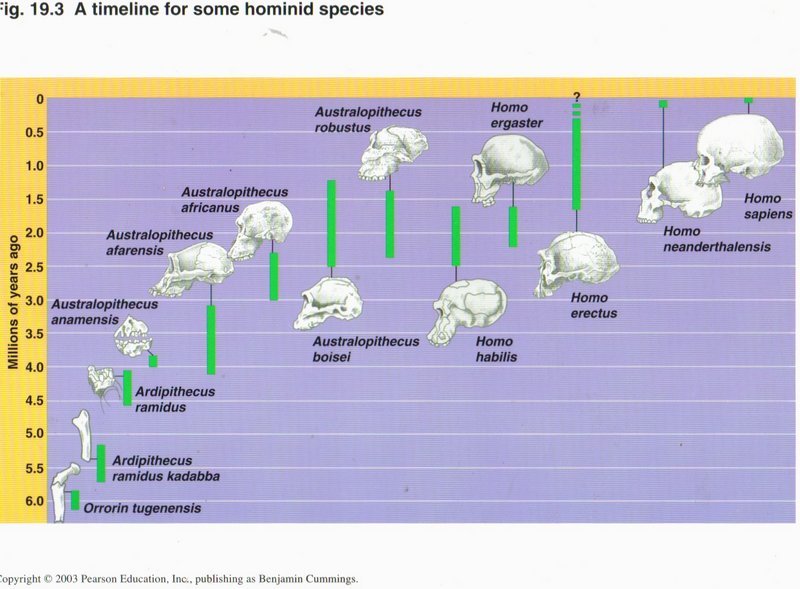
Darwinists believe modem man evolved through a series of homonids over the last 4-6 million years, with the Neanderthals the most
recent of these (from 2-4 hundred thousand to 28,000 years ago). From the dates given above it is obvious that there was a substantial
overlap (at least 12,000 years) when both specis were extant. Did we descend from the Neanderthals? There is a well-referenced article
on the internet entitled “Descent of Man Theory Disproven by Molecular Biology”, by Richard Deem, who cites scientific investigations
into DNA, bone structure, genetic diversity, and other areas, leading to the conclusion of the authors of the cited articles (most
published in the last decade) that man could not have descended from the Neanderthals or other homonids.
The Bible gives us some idea about the origin and distribution of the human race, but the time element is difficult to establish.
The principal time yardstick is obtained from the genealogies in Genesis 5, 10 and 11. It is easy to show that these genealogies
have gaps, but not how big the gaps are. Some Bible students have satisfied themselves that Adam and Eve were created betweem
40,000 and 50,000 years ago, and this agrees with the lower limits of age range for human origin given in the scientific literature.
Archeologists have studied the campfires and other relics of the Neanderthals as well as the oldest such relics of modern man, and
have determined that the two species were coexistent for several tens of thousands of years. What caused the Neanderthals to become
extinct? Were they destroyed by early modern man? Or did they succumb to the rigors of the Ice Age during which modern man survived?
We don’t know.
The knowledge of ancient man can only be acquired from a study of the fossils that have been found. These include tens of thousands
of stone and bone tools of many kinds, separate bones and partial or sometimes complete skeletons of animals and man. Art, in the
form of figurines, ornaments, and paintings and etchings in caves and other protected places tell much about their artists and the
society to which they belonged. What cannot be learned, obviously, are practices that did not produce durable fossils, such as
writing, language, agriculture, herding, home-making and many other areas of ordinary living. To say that these were not practiced
just because no fossils have been found to indicate them is certainly unjustified.
Click here for next page or Click here for more on the migrations of early man.
Although man must have had agriculture (see Genesis 4) and probably writing at the time of Adam’s creation, it is easy to see how
these arts could have been lost in the rigors of the thousands of years of glaciation during the last Ice Age -- which peaked
around 20,000 BC. In an article “The First Humans” compiled by the American Museum of Natural History (1993), we read: “Forty
thousand years ago, we were in a milder part of the last glacial period. But Europe had already experienced three cold spells since
the last interglacial, and the world looked very different from today. The sea level was 50 meters lower, the mountainous parts
of North America and Eurasia were glaciated and surrounded by windswept tundras, and the vegetation and climate zones were much
farther south than they now are. And the Big Chill was yet to come. Twenty-five thousand years ago, the ice caps started to
accumulate so much snow that large parts of northwestern Europe, North America, and alpine regions such as the Alps, and parts of
central Asia gradually disappeared under huge sheets of ice. These continental ice sheets reached their greatest extent 20,000
years ago, when the sea level dropped to 120 meters below the present level and parts of today’s continental shelf areas were
dry land. Land bridges were formed in many areas where today there are sounds, including the English Channel, Bering Strait, and
some of the sounds between Southern Asia and Australia. Most of Europe that was not actually under ice was virtually barren, with
only tundra and steppe vegetation, and exposed to wind and cold. The average temperature was about 8 degrees Celsius lower than
today.”
It is understandable that any people forced to live in such a rigorous climate would migrate to wherever they could hope for warmer
weather, and so man spread into Australia and New Guinea and into North and then South America by way of the land bridges then
existing. When the present interglacial warming took place, the ice sheets melted, the great fresh water lakes in Asia and North
America were formed, and the sea level rose gradually to its present level. The migrants could not return, nor could the
animals which probably preceded them. But the people living in the tropical portions of Earth did not have so much hardship, and
agriculture and writing could have survived from Adam’s day.
A very interesting article was mentioned in one of the books I read (I don't remember which one). It described a study of successive
generations of men and women. In women, the mitochondria are passed down only to female children by their mother. Similarly, the
Y-chromosome is passed down only to male children by the father. By counting the differences in the DNA between generations of
females and of males, one can make a crude approximation to the age of the original possessor of a perfect ribbon of DNA. The
interesting thing here was that the age of the first female with "perfect" DNA was several thousands years older than the first male
with "perfect" DNA. At first, one might attribute this to the error in the determination of age. But further thought would show that
the result should have been expected, since Noah would have been the one identified by the male study, but the four females in the
ark were unrelated to each other (presumably) and hence their common ancestress would have been Eve!
The chapter “Origin of the Human Language Capacity: In Whose Image?”, by John W. Oller, Jr., and John L. Omdahl (contained in “The
Creation Hypothesis”, 1994, edited by J. P. Moreland and published by Intervarsity Press), puts forward an argument that the human
language capacity is not just an improvement over the communicating abilities of lesser animals, but a wholly different capability
which no other creature possesses. Whereas a child has a full-fledged vocabulary by age six, including the capabilities of grammar,
imagination and expression of abstract ideas, the best a trained ape or chimpanzee can do in six years is to learn to respond to
a vocabulary of 200-600 words. Whereas young children are continually asking questions, the ape-like creatures never do, nor do
they ever initiate a communication. The inference is that the ape-like creature learns by rote, whereas the child has innate mental
abilities not possessed by the ape-like creatures.
Click here for next page.
Review of God’s Creative and Sustaining Acts
Seeing the astounding marvels God has brought about in the human brain makes it easier to understand His role in the physical realm
(discussed in the First Session). Just to briefly review those we emphasized earlier, remember the initial creative event of the vast
energy cloud that birthed the entire universe with its millions upon millions of stars and galaxies, and the origin of the orbital
motion of the stars with respect to their galactic centers, for which there is no natural explanation, which alone enables them to
exist for billions of years.
When we examine the known facts of the location of our Solar System and the Earth within it, we cannot avoid the sense of awe of
God's making these matters of importance to Him, because He was determined to give mankind the most ideal place in the entire universe.
For the location of the dust cloud from which was birthed our Sun and its solar system, including Earth, no better place could exist
than at the edge of one of the galactic arms of the Milky Way galaxy. From this vantage point man could examine the entire vast
universe in which our galaxy is one of millions. Were we located within the galaxy, we would never have discovered the rest of the
universe.
Also, this was the place where numerous nova and supernova explosions had left the dust cloud that contained the complete range of
atoms from hydrogen to uranium, all of them needed to produce life. Then there was the encounter with the huge asteroid that renewed
our atmosphere, gave the Earth its needed tilt (to establish seasons), created the moon with just the right size and distance from
Earth to control the tides, and provided minerals just below Earth’s surface so humanity could mine them. Why billions of years of
life on Earth before man? This enormous time span was needed for the life and death of countless millions of generations of plants
to create the vast deposits of coal and oil and other substances so essential to our economy, as well as to put oxygen into the air
for us to breathe. Science cannot account for the origin of DNA or the cell from natural law alone ― only intelligen design can
explain the original life forms and all the major changes in structure of living things since then controlled by the DNA in each
cell. To form such a complex of cells as we find our bodies to contain is also completely out of reach of natural law, beneficial
accidents and other props of Darwinism. Only a Supreme Intelligence such as the God of the Christian Bible could have accomplished
this.
Click here for next page.
Darwinism versus Creationism
Darwin’s basic theory, unintelligent minor changes incorporated into an organism if beneficial and thus leading to more complex
creatures, does not address the question of how the first creature arose. The theory attempts to explain how more and more complex
creatures are found in the fossil record as time goes by, but cannot, by its very nature, explain how the first creature came to be.
Since DNA is now recognized as the information source which governs all activities, present or future, of the organism, the problem
of origins expands to that of explaining the source of the first DNA. William Dembski has published several books describing the new
discipline of Intelligent Design. In the one of that name (1999, Intervarsity Press), he examines the nature of information in
considerable detail in Chapter Six: Intelligent Design as a Theory of Information. He uses information theory to show conclusively
that new information cannot be generated by chance or natural law. In particular, while natural law can transmit information from
one organism to another, it cannot increase it. He shows that where a more complex organism arises, there must be an outside source
of the additional information, either from the environment or from an intelligent source. He also shows that information from the
environment must have originated from an intelligent source. The net result of Chapter Six is the mathematical proof that only an
intelligent source can originate information. Darwinists frantically resist this thesis, but have not been able to refute it
successfully, though they have tried. Intelligent Design does not address the question of Who that intelligent source might be, or
when He created the information.
We examined the origin and development of the universe as a whole (First Session), and the development of the cell of which all life on Earth
is based (Second Session). All along there have been recurring references to places where natural law or chance cannot fully explain
the phenomena. I have quoted from the Bible, particularly the first chapter of Genesis, to show God’s supplying not only the origin
but each increase in complexity. Not previously mentioned is the fact that the four basic forces of the universe ― gravity,
electromagnetic force, the strong force (which holds protons together in the nucleus of an atom where their positive charges repel),
and the weak force (which governs radioactivity) ― have specific values that could not be even the slightest bit different
without destroying the fabric of matter. Other physical constants, such as the speed of light, are also very closely constrained in
value for physical laws to work. Darwinism does not address the source of these forces and the establishment of their values, but
once again intelligent design is the only reasonable answer.
Click here for next page.
Biblical views of creation
Let us now examine the case of the origin and increase in complexity of living things. The Bible attributes the origin of plants,
sea creatures and birds, land mammals, and finally man to four major acts of God’s creation (Genesis 1:11, 20, 24 and 27). How does
this Biblical account accord with Intelligent Design, the fossil record, and the current knowledge of DNA and its role in living
things? The most obvious agreement is the order in which these events occurred. Hugh Ross examines this question in his book, “The
Genesis Question” (1998, NavPress). He points out that Genesis 1 uses three different verbs to express God’s creative activity:
(1) “created” (Hebrew bara), bring forth something that is radically new; produce that which is new, extraordinary, and/or
epochal; produce through supernatural activity. God is always the subject of this verb in Genesis. bara is used only three
times: (verse 1) “In the beginning God created (bara) heaven and earth.”; (verse 21) “So God created
(bara) great sea creatures and every living thing that moves, with which the waters abounded according to its kind, and
every winged bird according to its kind.”; (verse 27) “So God created (bara) man in His own image."
(2) “let there be” (Hebrew haya), cause to appear or arise; cause to be made or done; come into existence; come to pass; make
into something. haya is used for the seven creation statements of verses 3, 6, 9, 11,20, 24, and 26.
(3) “made” (Hebrew asa), produce, manufacture, fabricate (without any indication of when.). asa is used in all
other places speaking of God’s creative acts.
I believe that these specific verb forms are related to the choices God made of being the primary immediate cause (bara),
possibly the secondary immediate cause (haya), or an unspecified type of previous cause (asa). Applying these
connotations to the fossil record and recognizing that each major type of life is mentioned only once in Genesis 1 and therefore
must include all species of that type over the whole fossil record, we can make a case for God as the source of the original and
additional DNA information as each new species appears. How He accomplished this, we probably cannot find out. We do have one example
of such an act in the virgin birth of Christ, as told us both in Matthew and Luke ― Matt. 1:20: "... behold, an angel of the
Lord appeared to him (Joseph) in a dream, saying, 'Joseph, son of David, do not be afraid to take to you Mary your wife, for that which
is conceived in her is of the Holy Spirit'", and Luke 1:35: "And the angel answered and said unto her, 'The Holy Spirit will
come upon you, and the power of the Highest will overshadow you; therefore, also, that Holy One who is to be born will be called the
Son of God.'" The Gospels are quite clear that Jesus’ body was wholly human, so his cells must have had the same two DNA helices
that all advanced animal and plant life have -- one from the mother (Mary) and the other from the father (the Holy Spirit). If the Holy
Spirit could introduce the male DNA contribution to the egg from Mary’s womb that was thus fertilized and produced the man Jesus,
surely He could do the same for the mother of each new species, plant or animal. How did God create Adam and Eve? Again we have no
answer from Scripture, but it is certainly within the bounds of possibility that He might have used any female as mother and provided
both male and female DNA helices in one or more ova from that (surrogate) mother. That is exactly what biologists do in cloning
animals. The timetable in the creation of Adam and Eve is not given, unless one insists on interpreting the phrase "So the evening
and the morning were the first (second, etc.) day" as referring to an earthly 24-hour day. Such an interpretation, which is not
linguistically required (the words involved have other meanings elsewhere in Scripture), is obviously irreconcilable with any
scientific understanding of any phase of creation, and is at variance with thousands of observable facts concerning the antiquity
of the earth and the heavens. It is certainly possible that God used a surrogate mother to produce both Adam and Eve, even a
Neanderthal mother. If He thought it desirable, he could have shortened the time of maturing for them. From the text of chapter 2,
we might infer that God took a cell from Adam’s side as the basis for Eve’s beginning, changing perhaps only the Y chromosome into
an X chromosome. These are merely anthropomorphic explanations ― obviously, God could have accomplished His purposes in any way
He chose.
Click here for next page or Click here for more on the interpretation of ancient Hebrew.
Final Thoughts
The recent studies of DNA, some of which have been described above, have revealed a remarkable similarity in its structure for all
living things. As already mentioned, the cell, either prokaryote for bacteria or eukaryote for all other types of life, is not only
complex, but has many features in common for all classes of living things. Darwinists take this as proof that their ideas of the
origin and development of life are correct. They can point to definite, if very rare, errors cells make in copying their DNA as the
undoubted mechanism by which the differences among living things can be and must be explained. A new species is born simply because
a member of the old made a certain number of errors when its DNA was last copied. Can that be true?
Many thinking scientists do not believe so. They point to the very large number of individual nucleotides that are different in
comparing species, even within the same family of living things. They also point to the fact that many structures in cells and higher
levels of organisms, cannot function unless every basic unit is present and correctly functioning. There are far too many features
that have to be “just right” for such a result to have come about by blind chance. They call the explanation “intelligent design.”
Who the designer is, is not specified. But the structure of the cell and of all organisms comprised of cells (and there are no
others), must have been designed and the original entry of the new design orchestrated by a Designer.
We who have accepted the teachings of the Christian Bible, believe firmly that the Designer is the God described therein. He is
described with all the attributes such a Designer must have, particularly knowledge, intelligence, power, eternal existence -- all
to a degree so much higher than the degree to which we humans possess these attributes, that to us they seem infinite.
If Our Designer, God, is so intelligent, knowledgeable, and powerful, why then is the DNA of all advanced life forms so far studied
so redundant? If He is the source of the DNA describing new genes to produce new features in a species, why did He not simply erase
any old genes that were no longer needed? I cannot answer that question. Just what physical means He used to change the DNA of an
older species to produce a new one, I do not know. We have only the brief description given in that first chapter of Genesis to
advise us. And that tells us simply that God is the author of certain of life’s forms but gives no hint of how He brought them
into being. There are other references to God’s creative acts in the Bible, but they give no further light on the “how.”
The Bible does relate numerous instances of “holy men of God” performing miracles, and Jesus the Christ perfomed a large number of
different kinds of miracles. But studying these accounts shows that in nearly every case, an existing quantity was extended
miraculously to many times its original amount, or a sick person is healed, or a dead person is brought back to life. Christ
stilled a storm on Lake Galilee, and walked on its surface, but when Peter tried to do so he sank into the waters (Matt. 14:25-31).
None of these miracles introduce a new form of life.
How did the Designer bring the first life into existence? Again, we don’t have a clue, as the saying goes. But it happened, not
just once, but several times ― we don’t know how many ― as huge meteorites blasted the surface of the Earth and the debris
contaminated the atmosphere, perhaps for centuries. The persistence of the need for “fine tuning” that has appeared in our study
of every major phase of the universe we live in is so pervasive that we can only believe, as John 1:3 says, that “All things were
made through Him (the Word, Who was God) and without Him nothing was made that was made.”
Resources Used in Preparation of Seminar
(1) The Age of Science (What scientists learned in the twentieth
century), by Gerald Piel (Founder of Scientific American Magazine). Published
2001 by Basic Books.
(2) Biology: Concepts and Connections (Third Edition), by Neil A.
Campbell, Lawrence G. Mitchell, and Jane B. Reece, a university biology
textbook. Published 2000, by Benjamin Cummings.
(3) Cell and Molecular Biology, by Stephen L. Wolfe, a university biology
textbook. Published 1995 by Wadsworth Publishing Company.
(4) The Creator and the Cosmos (Third Edition), by Hugh Ross. Published
2001 by NavPress.
(5) The Elegant Universe, by Brian Greene. Published 2000 by Vintage
Books.
(6) The Genesis Question, by Hugh Ross. Published 1998 by NavPress.
(7) Intelligent Design, by William Dembski. Published 1999 by
InterVarsity Press.
(8) Planet Earth and the New Geoscience (Second Edition), by Victor A.
Schmidt and William Harbert, a university textbook. Published 1994 by
Kendall/Hunt Publishing Company.
(9) Reason in the Balance: (The Case Against Naturalism in Science, Law
and Education), by Phillip E. Johnson. Published 1995 by InterVarsity Press.
Return to Herb's Place
Interpreting the Ancient Hewbrew Language
There are two major areas of conflict between creationists and Darwinists (to use terms commonly used to identify the groups of people
being discussed): (1) the length of the creation days, and (2) the extent of the Noahic flood. In both of these areas the English Bible
translations of the ancient Hewbrew text lead persons who believe in a literal interpretation of this English to demand that this text
should be interpreted literally if one “believes the Bible.” I want to show that there are other possible interpretations of the
ancient Hebrew text of Genesis 1-l1, that are supported by other portions of the Bible.
1. The Length of the Creation Days. The repeated phrase, “And there was evening, and there was morning--the (first, second, . . .
sixth) day.” is interpreted as referring to present Earth’s 24-hour day by literalists. The possible meanings of the key words are:
evening (Hebrew ‘ereb): the beginning of darkness; dusk, twilight, or nightfall; closing, ending, or completion.
morning (Hebrew ra’a): the breaking forth of light; dawn, daybreak, or morning; dawning, beginning, or origin. day
(Hebrew yom): sunrise to sunset; sunset to sunset; a space of time (defined by an associated term): an age; time or period
(without any reference to solar days).
One can see why the translators of the King James Bible of 1611 used the words they did, which have been followed by all translaters
since. There are many references to God’s requirement that mankind should limit his work week to six 24-hour days and rest on the
seventh, because that is what God did in His creation work. So there is ample justification from the Hebrew language and Biblical
reference to accept the literal 24-hour day as what is meant in the Genesis 1 statements referred to above.
One must recognize, however, that the people of 1611 had no clue as to the nature of the Sun, Moon and stars, nor of the geologic
history of Earth. Most of this knowledge has been accumulated in the last century. Also, one must recognize that ancient Hebrew was
a very limited language, compared to English, and had very few words with solely abstract meanings. Instead they used ordinary words
related to the abstract terms. We do the same thing in our language, particularly in poetry. Also, when comparing God’s ways to man’s
ways, the Bible is vehement in declaring them different. This certainly implies that God is not limited to Earth days in His actions.
Taking the last of the meanings of these three terms as given above, removes the problem of earthly 24-hour days. The Bible itself
uses yom to mean a period of time in excess of 24 hours. In the second chapter of Genesis (verse 4) we read: This is the
history of the heavens and the earth when they were created, in the day (yom) that the Lord God made the earth and the
heavens. Obviously, the word “day” must include all six of the creation “days.”
Further in chapter 2, we have the story of Adam’s loneliness, of God’s bringing all the animals and birds to him for him to name and
to see if any would be a suitable companion for him. Since none were suitable, God then created Eve from a portion of Adam’s flesh
taken from his side. Now, how long would it take for Adam to name all the animals and all the birds? If we limit the numbers of these
creatures to those specifically named elsewhere in Genesis, it reaches over the hundred mark. If we think of all the animals and birds
created during the life-time of Earth, it runs into the millions. Even the smaller number would require many hours of Adam’s time, if
he carefully considered the characteristics of each creature in order to give it an appropriate name, as the culture of the ancient
Hebrews required. From this consideration alone it is difficult to reconcile the length of time between Adam’s creation and Eve’s
ceation to one 24-hour day, as is stated in Genesis 1:26-31.
Finally, Genesis 2:3 states that God blessed the seventh day and sanctified it, because in it He rested from all His work which God
had created and made. But the seventh day is not stated to have closed. In fact, Hebrews 3:7-4:10 has quite a discussion of the
nature of God’s rest on the seventh day, and quotes Psalm 95:7-11 as showing that it is still possible for God’s people to enter into
that rest with God. Hence the seventh day is still not ended.
2. The Extent of the Noahic Flood. The classic case for the world-wide extent of the Noahic flood was made in the book “The
Genesis Flood”, Henry Morris being the principal author. In it he attempts to show that all the geologic features, including the
mountains, the vast stores of coal and oil and other valuable minerals were generated by that one event in 40 days, as related in
Genesis 7: 17-21: Now the flood was on the earth 40 days. The waters increased and lifted up the ark, and it rose high above the
earth. The waters prevailed and greatly increased on the earth, and the ark moved about on the surface of the waters. And the waters
prevailed exceedingly on the earth, and all the high hills under heaven were covered. The waters prevailed fifteen cubits upward,
and the mountains were covered. And all flesh died that moved on the earth . . . The key words are “high hills”, “mountains”,
and “covered.” The Hebrew word har can mean “hill”, “hill country”, or “mountain.” The adjective gaboah means “high”,
“exalted”, “elevated”, or “lifted above.” The word kasah means “residing upon”, “running over”, or “falling upon.” As in the
case of the 24-hour days, translaters have a choice of several possible meanings for the Hebrew words they are translating into English.
Recognizing Noah’s limitations on his understanding of what constituted “all the high hills under heaven”, we can safety limit the
area of the flood to the major plain constituting the region of Mesopotamia. That region has a perimeter of low mountains and high
hills that encompass an area of many hundred square miles, and includes numerous small hills. This area is also known in ancient
writings as “the mountains of Ararat” (notice the plural of “mountains”). Flood waters could rise above those small hills to a depth
of “15 cubits” and put Noah out of sight of land, without the necessity of flooding even the entire Arabian peninsula, much less our
understanding of the entire world. Further, as all the text of Genesis 4-11 shows, humanity had refused to “populate the earth” as
God had commanded, and remained concentrated in the Mesopotamian region. So all mankind not in the ark would be drowned even if the
flood covered no more than that part of Mesopotamia.
Other objections to a world-wide flood include: (1) wind, as stated in 8:1, would have no effect in removing the flood if the waters
covered the Earth as we know it; (2) The ark, whose size is specifically given, could not begin to house all the clean and unclean
animals and birds God commanded Noah to take into the ark (7:2,3) if the flood were world-wide, as the present number of animal and
bird species runs into the hundreds of thousands; (3) olive trees do not grow in salty soil and would be killed in a flood involving
ocean water, but are identified as living immediately after the flood when the dove brought back to the ark an olive leaf (8:11);
(4) the amount of coal, oil, and limestone known to exist under the earth’s surface, to mention only these “minerals”, greatly
exceeds that which could have been generated in 10,000 years; (5) there is no known source of enough water to cover the earth to a
height of Mount Everest, and even more to the point, no sink for such a huge amount of water to “subside” into.
It is evident to any thinking person, that the belief in 24-hour Earth days for creation and a world-wide flood is based solely on
a specific interpretation in English of the ancient Hebrew description of these events in Genesis, whereas there are equally valid
translations possible without doing violence to the Hebrew text, which remove the barriers to the reconciliation of science and the
Biblical statements.
Click here for next topic.
Early Migrations of Humanity
1. Date of the Creation of Adam and Eve. When did the first ancestors of our species (homo sapiens) live? Bishop Usher thought
Adam and Eve were created in 4004 BC, arriving at this figure by taking the genealogies of Jesus and others from the Bible. But how
much can we depend on those genealogies? It is easy to show that there are gaps in them. The Hebrew word for “son” (bar) can
mean grandson or even a further male descendent. A case can be made that the genealogy of Moses is abbreviated directly from the
ages and genealogies given in the Bible. The genealogy of Moses is given in Exodus 6:16-20: "These are the names of the sons of
Levi according to their generations: Gershon, Kohath, and Merari. And the years of Levi were 137. .. And the sons of Kohath were
Amram,. . . And the years of the life of Kohath were 133. . . Now Amram took for himself Jochebed, his father’s sister, as wife:
and she bore him Aaron and Moses. And the years of the life of Amram were 137."
Exodus 12:40 states: "Now the sojourn of the children of Israel who lived in Egypt was 430 years." Since Moses was 120 years
old at his death (Deuteronomy 34:7), 40 years after leaving Egypt, the Exodus occurred when Moses was 80. Kohath, the direct ancestor
of Moses, entered Egypt at the beginning of the 430-year sojourn as a boy or young man (Genesis 46:11), and died at age 133. Amram,
specifically stated as the father of Moses, lived 137 years, and Moses was 80 at the time of the Exodus. These years cannot reach the
sojourn time of 430 years even if Kohath and Amram sired their sons in their last year of life, a highly unlikely happening. Hence
several generations must have been skipped in Moses’ genealogy. There are several other genealogies where it is evident generations
have been skipped, in particular the genealogy of Jesus as given by Matthew and Luke.
How many generations were skipped in the ancestors of Noah (Genesis 5) and the link between Noah and Abraham (Genesis 11:10-26) cannot
be determined from the Bible. It is obvious that there are gaps in this link, for the ages given would have Noah still living at the
time of Abraham’s birth. Abraham was a historical person, whose lifetime can be determined from many sources, but the time of creation
of Adam and Eve and of the Noahic flood can only be estimated from other sources. It would appear unlikely to have been earlier than
30,000-40,000 BC., but most certainly much earlier than Usher’s calculation of 4004 BC.
2. Early Migrations of Mankind. The only Biblical statements about the dispersal of mankind after the flood are given in Genesis
10 and 11. According to chapter 11, mankind had not dispersed beyond Mesopotamia at the time of the Tower of Babel, making it necessary
for God to intervene and confound their single language. He scattered them abroad over the face of the whole earth (Genesis 11:9).
The “whole earth” to the writer of Genesis (Moses) was most likely not more than the Middle East region.
In a popular book, “The Journey from Eden”, by Brian M. Fagan (1990), supplemented by “The First Humans: Human Origins and History to
10,000 BC”, compiled by the American Museum of Natural History (1993), we can gain an insight to the thinking of the academic world
concerning the early migrations of the human race. To quote from the latter, “Paleotemperatures and paleo-ice volumes, deduced from
oxygen isotope records in deep-sea cores, reveal.. . (that) during the last 700,000 years, the dominant cycle (of glacial-interglacial
periods) has been about 100,000 years, including interglacials lasting 10,000 to 15,000 years. The most recent Ice Age began about
115,000 years ago and ended about 10,000 years ago, when the present interglacial was initiated. It was in this period that Homo
Sapiens, or modern human beings, developed. They had to adapt to quite rapid changes which had a huge impact on the geological and
other features of this planet. Forty thousand years ago, we were in a milder part of the last glacial period. But Europe had already
experienced three cold spells since the last interglacial, and the world looked very different from today. The sea level was 50 meters
(165 feet) lower, the mountainous parts of North America and Eurasia were glaciated and surrounded by windswept tundras, and the
vegetation and climate zones were much farther south than they now are. And the Big Chill was still to come.
“Twenty-five thousand years ago, the ice caps started to accumulate so much snow that large parts of northwest Europe, North America,
and alpine areas such as the Andes, the Alps, and parts of central Asia gradually disappeared under huge sheets of ice. These
continental ice sheets reached their greatest extent 20,000 years ago, when the sea level dropped to 120 meters (390 feet) below the
present level and parts of today’s continental shelf areas were dry land. Land bridges were formed in many areas where today there
are sounds, including the English Channel, Bering Strait, and some of the sounds between Southern Asia and Australia. Most of Europe
that was not actually under ice was virtually barren, with only tundra or steppe vegetation, and exposed to wind and cold. The average
temperature was about 8 degrees Celsius lower than today.”
Dr. Fagan’s map showing his estimates of the earliest presence of modern humans in various parts of the world are:
Europe, 40,000 years ago;
Siberia, 35,000-25,000 years ago;
Alaska, 15,000 years ago;
Western USA, 11,500-11,000 years ago;
Central and South America, (less than 10,000 years ago);
India and Southeast Asia, (more than 40,000 years ago);
Australia and New Guinea, 40,000 years ago;
Fiji-Tonga, 4,000-2,000 years ago
Marquesas Islands, Society Islands, Easter Island, 1,500 years ago;
Hawaii, 1,400 years ago;
New Zealand, 1000 years ago.
Numbers in parenthesis are my estimates, since Dr. Fagan did not date these areas. His map also shows the eastern coastal area of
Africa as “ancestral modern humans, 150,000-100,000” years ago, and the Middle East, 90,000 years ago. Reading the text of his book
shows that the African and Middle East dates arise from a single site in each area, in which even he did not place much confidence.
There is much evidence for the other dates given.
It is interesting to note that forty thousand years ago was a time of relative warmth in the last glacial cycle, and that is the date
given for the major migrations from the Middle East. It is also about the earliest date that we can infer from the (gap-filled)
genealogies in the Bible. The description of life during the last glacial period emphasizes God’s sentence on Adam and Eve for their
rebellion against His authority given in Genesis 3:17-18: "Cursed is the ground for your sake; in toil you shall eat of it all the
days of your life. Both thorns and thistles it shall bring forth for you, and you shall eat the herb of the field."
The knowledge of ancient man can only be acquired from a study of the fossils that have been found, mostly around ancient camp fires.
These include tens of thousands of stone and bone tools of many kinds, separate bones and partial or sometimes complete skeletons of
animals and man. Fooprints and other impressions also reveal something about their makers. Art, in the form of figurines, ornaments,
and paintings and etchings in caves and other protected places tell much about their artists and the society to which they belonged.
In later years, pottery became a major source of dating, as styles in pottery seem to have spread rapidly throughout the occupied
world. What cannot be learned, obviously, are practices that did not produce durable fossils, such as writing, language, agriculture,
herding, home-making, and many other areas of ordinary living. To say that these were not practiced because no fossils have been
found to indicate them is, in my opinion, unjustified.
Because of the absence of fossils indicating agricultural practices and herding, all archeologists quoted believe man existed by
hunting (by the men) and gathering (largely by the women). They were very mobile, as necessary to follow the migrations of game
animals, and so did not have permanent homes or cities. In the more frigid climates, they wintered in such sheltered places as
caves and arroyos that they could find, and it is in such places that most artifacts have been found. The major advances over the
thousands of years of such roaming were “largely restricted to the art of toolmaking. The finding of tools made in similar ways has
led to a belief in considerable communication over hundreds of kilometers (miles), and also serves to confirm uncertain dates in
one area by similar tools in another much better-dated area. Nevertheless, these writers believe that writing and agriculture did
not exist prior to 10,000 BC.
The Bible gives little information about life prior to the flood and even after it up to the time of Abraham (2,000 BC). We do know
from Genesis 4 and 9 that Abel was a hunter and Cain and Noah were farmers, so that farming must have continued right through the
millenia since Eden. Whether or not these early Biblical persons practiced writing, we have no direct evidence, but Abraham must
have practiced that art, and the possibly much earlier Job also. It is hard to conceive of Noah building such a large vessel if
he didn’t have writing to keep track of things. The oldest writings from the Middle East show quite distinct ways of writing, which
must have diverged from the original style over the centuries. Nimrod, descended from Noah, founded several cities. And of course,
there is the city of Babel (Genesis 11). I noted that the archeologists cite almost no artifacts from the Middle East prior to
6,000 BC. Hence, the knowledge of human life from Eden until 10,000 BC is almost exclusively from the campfire fossils of Europe
and Asia (in areas subject to the Ice Age).
The coming of Jesus Christ into the world initiated a new era for God’s people. While the age of the New Testament is filled with
violence, immorality, oppression and injustice, the history of the world since then has shown a steady if uneven progress toward a
more benign society, such as the age in which we live. This age is far from ideal, of course, for God doesn’t want us to confuse
Earth with heaven. But when we consider the many ways in which God specially prepared the Earth for our home, it adds new wonder
and awe to that which is due from His redeeming grace.
Click here for next topic.
Vertebrate Organ Systems

Here we see the first seven of the twelve organ systems of a human.
A. Digestive System. Here we see the organ pathway our food takes through the body. It starts in the mouth. There teeth
masticate the food into small pieces, and saliva provides several substances: a soft glycoprotein that encompasses hard bundles of
food, buffers to neuralize acids, an antibacterial agent to kill potentially harmful bacteria, and a digestive enzyme to begin the
hydrolyzing of starch.
The pharynx houses both the trachea (for breathing) and the esophageal opening. Normally the trachea is open for breathing, but when
we need to swallow food or drink, the epiglottis moves down to close off the trachea and open the esophagus for the entry of the
food bolus. I personally suffer from a defective epiglottis, which allows air to enter the esophagus, particularly when I drink.
When the food bolus has entered the esophagus, smooth muscles constrict above it, forcing it down into the stomach.
The stomach is lined with tubes containing digestive glands: one secretes mucous to lubricate the food, one secretes hydrochloric
acid (HCl), and the third secretes pepsinogen. Once in the stomach interior in contact with the food, the HCl converts the inactive
pepsinogen to the active form pepsin, an enzyme which breaks down the long chains of proteins into smaller chains which are further
digested in the small intestine. Some nutrients are absorbed directly into the blood stream from the stomach walls. The stomach
lining is somewhat protected from the pepsin by the mucous, but the epthelial cells are constantly in need of replacement, so that
the entire stomach lining is renewed every three days or so. Failure of the mucous to protect the stomach lining produces ulcers.
The small intestine (over 6 yards long and 1 inch in diameter in humans) receives the partly digested food from the stomach, and
completes the digestive process, aided by the liver, the gall bladder and the pancreas. Starch (a polysaccharide) is first reduced
to maltose (a disaccharide) and then to a sugar (monosaccharide) by several enzymes. Proteins (polypeptides) are broken down into
smaller polypeptides and finally into amino acids by additional enzymes. Nucleic acids (found in meat and vegetables) are reduced to
nucleotides and these into nitrogenous bases, sugars and phosphates by still other enzymes. Fats are emulsified into droplets, and
these broken down into fatty acids and glycerol. The liver has many functions, and provides bile to emulsify fats. The gall bladder
stores bile until it is needed. The pancreas produces several enzymes and an alkaline solution which neutralizes the acids coming
from the stomach. The small intestine’s wall of epithelial cells is covered with recesses which expose the cells to the blood vessels
outside the wall for absorption of nutrients into the blood stream. Smooth muscles move the food along the intestine by peristalsis,
a running constriction which forces the bolus through the channel.
The large intestine or colon (about 2 yards long and 2 inches in diameter in humans) serves to store undigested food and remove
excess water, about 8 quarts per day, which is recycled back into the blood and tissue fluids. Bacteria, such as E. coli, produce
inportant vitamins which are absorbed into the blood stream. The terminal portion of the colon is the rectum leading to the anus
at the surface of the body.
Runinant animals, such as the cow, have a more complex digestive system, with much recycling, to allow bacteria to convert cellulose
into digestible food.
Click here for next page.

B. The Respiratory System. The respiratory system provides the animal with molecular oxygen (O2) and disposes of
carbon dioxide (CO2. Primitive animals (such as earthworms) use the entire skin as their respiratory system, but vertebrates
use lungs (land animals) or gills (water animals). In the human, the larynx and trachea in the throat connect with the bronchus, which
in turn connects to each of the two lungs. Within the lung is a complex of folds whose surfaces are lined with capillaries, wherein
the cells discharge CO2 and absorb O2. The diaphragm is the pump that enlarges the lung cavity to inhale fresh
air and compresses it to exhale stale air. The muscles operating the diaphragm are controlled both voluntarily and involuntarily
through a monitor in the brain measuring the amount of CO2 in the blood stream.
Click here for next page.

C. The Circulatory System. The Circulatory System provides a means of bringing oxygen and nutrients to each cell of the body
and removing CO2 and waste products from the cells. The heart is the muscular organ that moves the blood through the
two-part system, containing thousands of miles of passages.
In the pulmonary circuit, the blood flows from the heart in two arteries to the lungs, where it passes through many arterioles into
thousands of capillaries, where CO2 is discharged and O2 is acquired, thence through many venules into four
veins back to the heart.
In the systemic circuit, the blood flows from the heart through many arteries to the various organs, where arterioles, capillaries and
venules take it through the organs into veins, which return it to the heart. The heart is actually a dual pump, the right side powering
the pulmonary circuit and the left side powering the systemic circuit. Since the latter is much more extensive, the left side is
proportionally more powerful. The blood pressure caused by the heart sends spurts of blood through the arteries, which expand to absorb
the impact (you can feel this expansion in your pulse), but the pressure is greatly diminished on entering the arterioles and becomes
almost zero in the capillaries. Movement of the blood back to the heart through the veinous portion of the systemic circuit, mostly
uphill for us humans, requires muscular effort along the way by the veins and surrounding skeletal muscles. Numerous valves prevent
back flow of the blood. The interchange of gases and nutrients/waste products between the cells and the capillaries is via the
interstitial fluid that bathes the cells. All such interchange is by diffusion of high density gas or ions to lower density, thus not
requiring ATP to provide energy.
Red blood cells (humans have about 25 trillion) are unique in structure and function, in that they have no nucleus or mitochondria,
but each cell has about 250 million molecules of hemoglobin, the protein that carries four iron atoms, each holding a molecule of
oxygen during the trip from the lungs to the capillaries. Hemoglobin also transports the CO2 from the capillaries to the
lungs.
The heart, about the size of a doubled-up fist and weighing less than 2 pounds, is without doubt the most efficient machine ever
designed. What machine man has designed can operate 20-30 times a minute steadily without pause (for maintenance or repair) for over
100 years? The amount of blood pumped by the heart in a lifetime would fill a train of tank cars 25 miles long! And this marvelous
device came about by accidental causes? Ridiculous!
Click here for next page.

D. The Lymphatic and Immune Systems.
1. The nonspecific defenses of the body. The skin is the first line of defense against harmful invaders, such as microbes,
bacteria and viruses, many of which cannot penetrate its tough barrier of dead cells. Acids in sweat and oils secreted by glands in
the skin inhibit the growth of many micro-organisms. Sweat, saliva and tears contain lysozyme, an enzyme that attacks the cell walls
of many bacteria. The digestive and respiratory systems are protected by mucous, which sweeps up invaders and removes them from those
organs. Stomach acid kills most bacteria swallowed with food.
When some types of cells are invaded by bacteria or viruses, on the death of the cell they produce and release into the interstitial
fluid interferon, a protein which enables healthy cells to inhibit the reproduction of viruses. Several kinds of white blood cells are released into interstitial areas, where they eat bacteria, viruses, and body cells that have
been invaded. The inflammatory response shown below is a type of this activity.
Click here for next page.
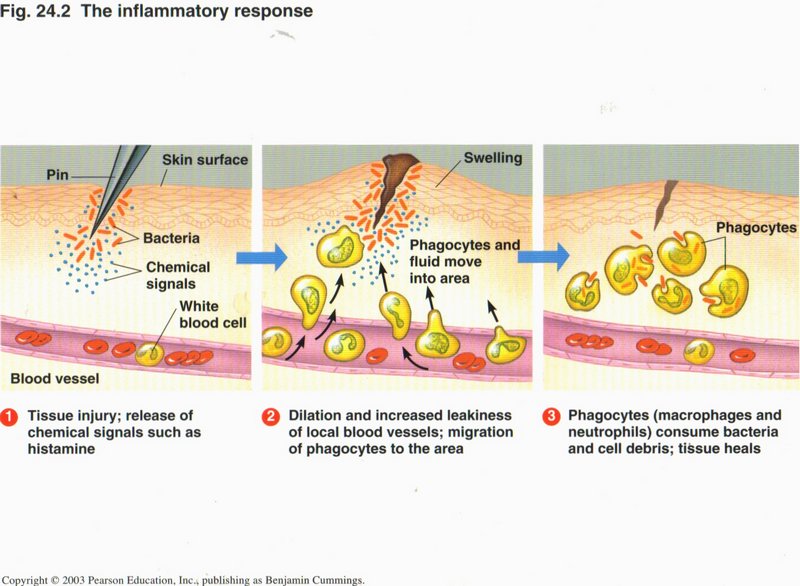
When the skin is penetrated by a dirty needle, a mosquito or other insect, (1) the damaged cells release chemical signals (such as
histamine). (2) The histamine dilates the nearby capillaries which allows phagocytes (killer white cells) and fluid to escape and
penetrate the injured area. This causes swelling and heating. The phagocytes quickly eat the invading bacteria and allow healing to
take place.
Click here for next page.

2. Specific defenses of the body. When viruses or bacteria become established in the body and multiply, the nonspecific defenses are inadequate to cope with the
invasion, and the much more sophisticated specific defense system, called the lymphatic system, comes into play. The system consists
of a network of lymphatic vessels connecting most of the cellular interstitial areas with the lymph nodes, where specialized white
blood cells await activation.
The lymphatic system has two main functions: to return tissue fluid to the circulatory system, and to fight infection. In figure B,
we see the excess interstitial fluid being taken up by a lymphatic vessel, from where it will drain into larger and larger nymph
vessels, and will reenter the circulatory system through the right lymphatic duct or the thoracic duct, as shown in figure A. The
lymph will pass through one or more lymph nodes (shown in figure C) where it will be exposed to lymphocytes (white blood cells
programmed to recognize and attack specific invaders) and phagocytes (which attack all foreign invaders to engulf them).
Click here for next page or Click here for more detailed discussion of B & T cells.
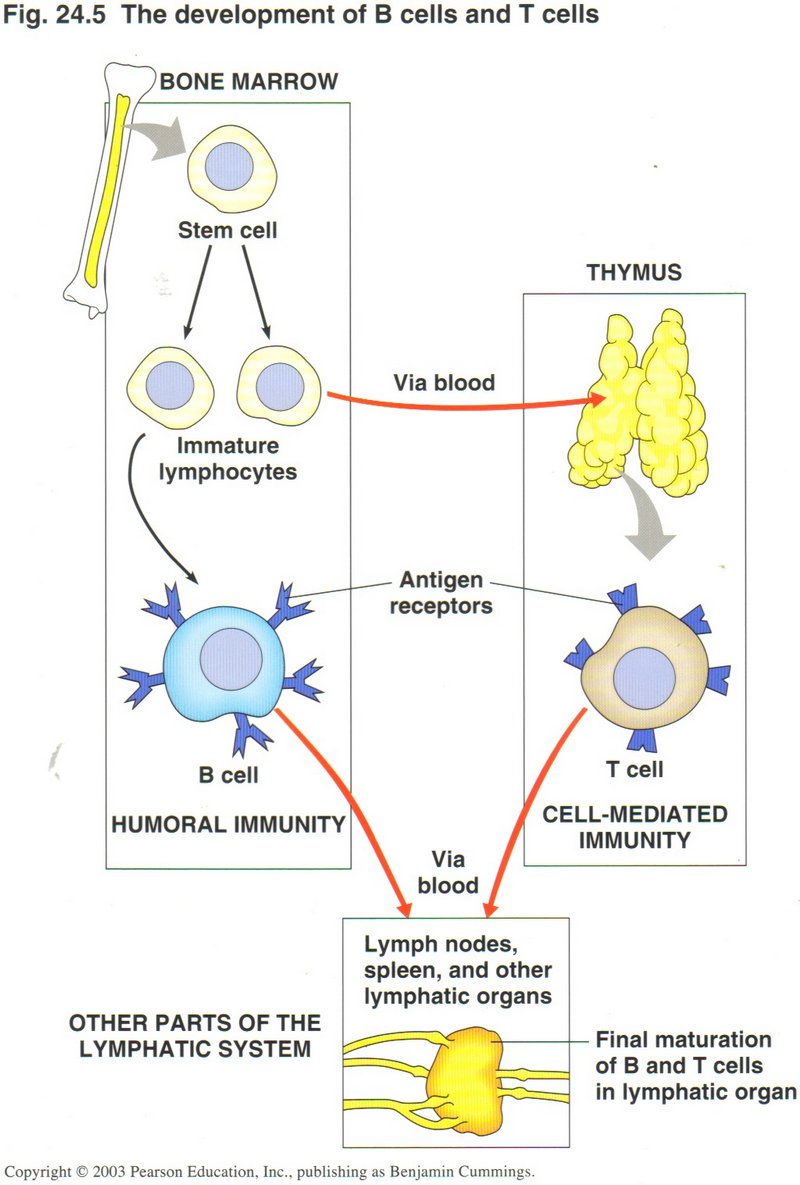
In the bone marrow, stem cells specialize into immature lymphocytes, some of which mature into B cells to provide humoral immunity,
and others which are carried by the blood to the thymus, where they mature into T cells to provide cell-mediated immunity. Both
types are carried by the blood to the lymph nodes, spleen and other lymphatic organs.
Click here for next page.
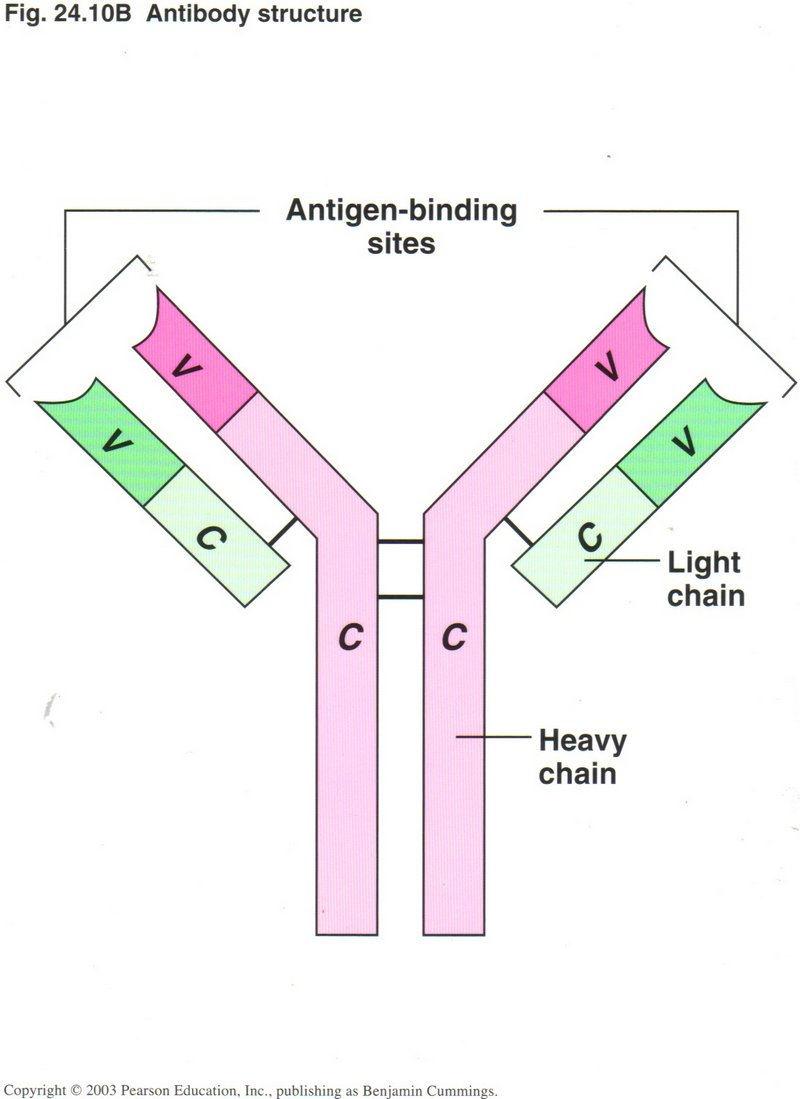
B Cells. Each B cell is specifically programmed in the "V" portion of the light chain to produce a particularly shaped
molecule, called an antibody, shown here. There are literally millions of such specially shaped antibodies needed to match the shape of
every possible invading molecule (called an antigen), either on the wall of a bacterium or virus or on an inanimate duct particle.
Click here for next page.

The invading antigen usually has several sites on its exterior to which different antibodies may bind, as
shown here at "A" and "B". These antibody molecules are released into the interstitial fluid of the lymph node. Thus there are millions
of differently specialized B cells stored in the lymph nodes and other lymph organs.
Click here for next page.
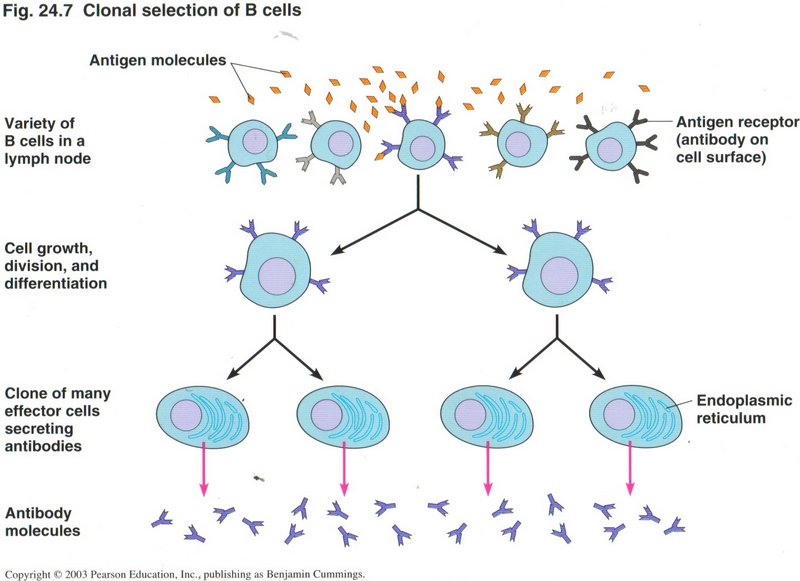
When an antigen is brought into a lymph node by a connecting lymph vessel, it will usually bind to the matching antibody on the
surface of the B cell. The binding of the antigen to the antibody causes a signal to be given to that cell’s reproduction machinery
to begin cloning itself into thousands of copies as shown here.
Click here for next page.
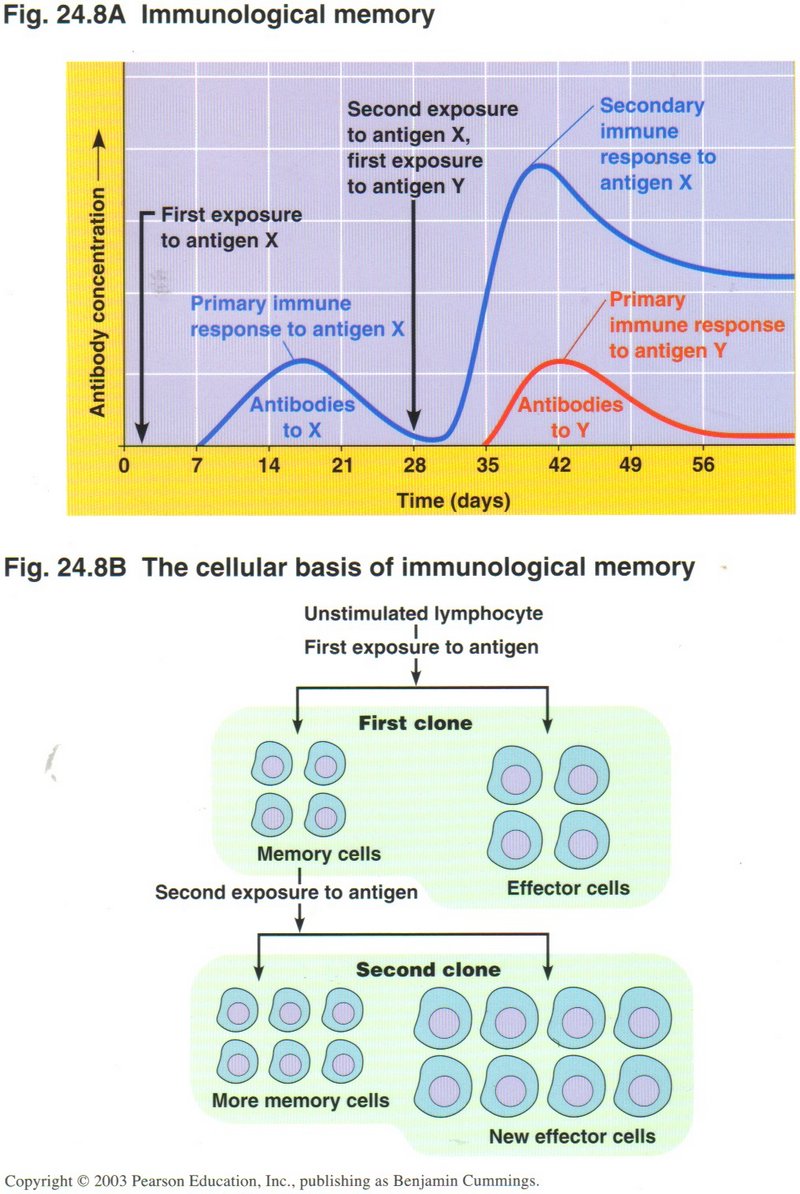
The cellular basis of immulogical memory. As shown here, the first time (primary response) this particular antigen is recognized
by the B cell designed for that specific antigen, the response is slow and not great, as shown in the graph of figure A, where a sample
period of two weeks is required to reach peak response. However, in addition to the effector cells which attack the invader but die
soon after, the cloning also produces a fewer number of memory cells, which can live for years waiting for the next invasion of that
particular antigen. On the second exposure (secondary response), the response is much quicker and greater, since there are now many
more (memory) cells that can recognize this particular antigren.
Click here for next page.

This response growth in repeated exposures to the same antigen is highlighted here -- first exposure (blue) and
second or following exposures (red) to a particular antigen. Thus, if a person is vaccinated with a benign colony of the
particular antigen (such as a flu virus), memory cells are generated which will be available for a more aggressive attack on the
invader whenever that is called for (perhaps years later).
Click here for next page.
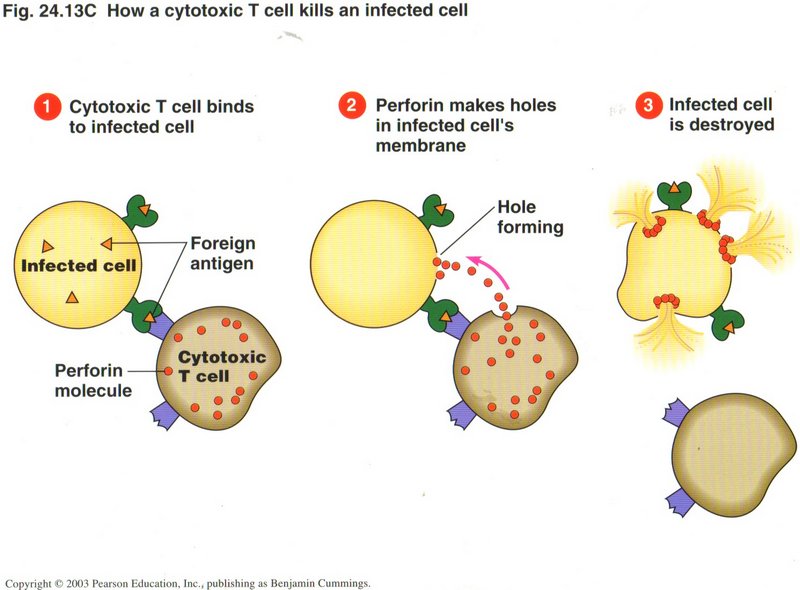 Here you see what happens to an invader or infected body cell when it has been bound to one or more antibodies. It is then prey for the phagocytes
(macrophages) which inhabit the lymph node and other areas. Antigen/antibody complexes also cause some dissolved antigens to be
precipitated and thus available for engulfing by macrophages; they also activate special proteins which circulate in an inactivated
form until contact with the complex, upon which they change shape and literally bore holes in the foreign cells, thus causing them
to burst and die.
Here you see what happens to an invader or infected body cell when it has been bound to one or more antibodies. It is then prey for the phagocytes
(macrophages) which inhabit the lymph node and other areas. Antigen/antibody complexes also cause some dissolved antigens to be
precipitated and thus available for engulfing by macrophages; they also activate special proteins which circulate in an inactivated
form until contact with the complex, upon which they change shape and literally bore holes in the foreign cells, thus causing them
to burst and die.
Click here for next page.
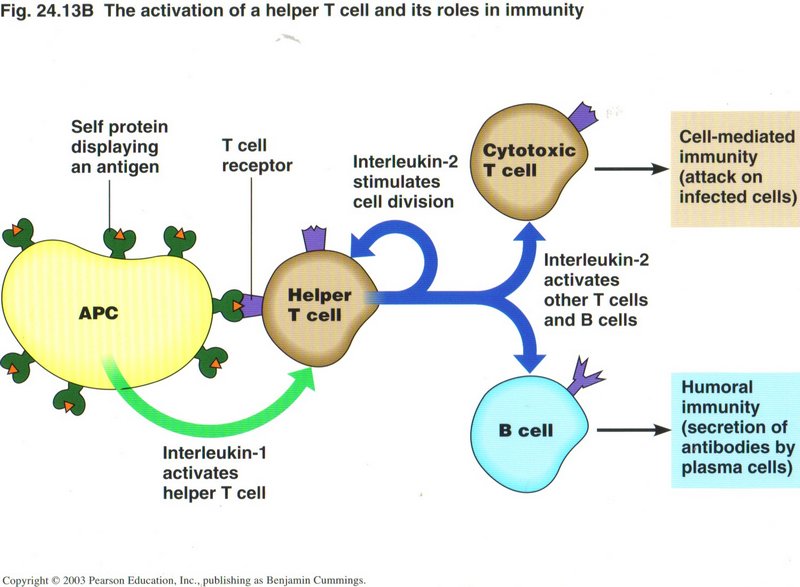 T Cells. Whereas B cells operate in the interstitial fluid surrounding cells, T cells act to destroy infected
cells, and thus prevent the multiplication of viruses. They must first be prepared to do so, and this is the function of the helper T cell. As shown here, when
a macrophage (here called an APC ― antigen-presenting cell) has ingested a microbe, it destroys the microbe, creating many pieces
as antigens; it also produces the special protein identifying self. These self proteins are embedded in the macrophage’s plasma
member, each holding an antigen. When an appropriate Helper T cell encounters the macrophage, it binds to one of the sites of the
self/antigen complex.
T Cells. Whereas B cells operate in the interstitial fluid surrounding cells, T cells act to destroy infected
cells, and thus prevent the multiplication of viruses. They must first be prepared to do so, and this is the function of the helper T cell. As shown here, when
a macrophage (here called an APC ― antigen-presenting cell) has ingested a microbe, it destroys the microbe, creating many pieces
as antigens; it also produces the special protein identifying self. These self proteins are embedded in the macrophage’s plasma
member, each holding an antigen. When an appropriate Helper T cell encounters the macrophage, it binds to one of the sites of the
self/antigen complex.
Click here for next topic.

E. The Excretory System. The excretory system disposes of waste fluids, which are drained from the blood as it passes through
the kidneys. From there the waste fluid passes through the ureters into temporary storage in the urinarybladder, from which it is
voluntarily emptied through the urethra.
Click here for next page.

F. The Endocrine System. The endocrine system is the collection of glands (pineal, pituitary, thyroid, thymus, adrenal) and
other organs (pancreas, testis, ovary) that produce and secrete into the blood stream various hormones that regulate many activities
of the body, such as digestion, metablism, growth, reproduction, heart rate, and water balance.
Click here for next page.

G. The Reproductive Systems. The reproductive systems produce the male and female gametes (haploid cells), whose union in the
female generate the zygote (diploid cell) from which a new organism will develop. These systems also include the organs which allow
fertilization to occur.
Click here for next page.

H. The Nervous System. The nervous system works together with the endocrine system to coordinate body activities. The brain
receives information from the sense organs (eyes, ears, nose, mouth, skin) and sends signals through the system of nerves branching
out from the spinal cord. Rather than tubes to conduct fluids, such as the circulatory and lymph sysytems, a nerve channel is a chain
of linked axons of nerve cells.
Click here for next page.

I. The Muscular System. The muscular system consists of all skeletal muscles under voluntary control, which permit movement of
the various parts of the body. Such muscles area ttached to the bones or cartilage structures, and are controlled by nerve impulses.
The heart muscles and the smooth muscles of blood vessels, intestines, and the like are considered to be parts of other systems.
Click here for next page.

J. The Skeletal and Integumentary Systems. The skeletal system is the system of interconnected bones that support and protect
the body. The integumentary system consists of the skin and its derivativres, hair and nails. Its major function is to protect the
internal body parts from mechanical injury, infection, excessive heat or cold, and drying out.
Click here for next topic.












 Here you see what happens to an invader or infected body cell when it has been bound to one or more antibodies. It is then prey for the phagocytes
(macrophages) which inhabit the lymph node and other areas. Antigen/antibody complexes also cause some dissolved antigens to be
precipitated and thus available for engulfing by macrophages; they also activate special proteins which circulate in an inactivated
form until contact with the complex, upon which they change shape and literally bore holes in the foreign cells, thus causing them
to burst and die.
Here you see what happens to an invader or infected body cell when it has been bound to one or more antibodies. It is then prey for the phagocytes
(macrophages) which inhabit the lymph node and other areas. Antigen/antibody complexes also cause some dissolved antigens to be
precipitated and thus available for engulfing by macrophages; they also activate special proteins which circulate in an inactivated
form until contact with the complex, upon which they change shape and literally bore holes in the foreign cells, thus causing them
to burst and die. T Cells. Whereas B cells operate in the interstitial fluid surrounding cells, T cells act to destroy infected
cells, and thus prevent the multiplication of viruses. They must first be prepared to do so, and this is the function of the helper T cell. As shown here, when
a macrophage (here called an APC ― antigen-presenting cell) has ingested a microbe, it destroys the microbe, creating many pieces
as antigens; it also produces the special protein identifying self. These self proteins are embedded in the macrophage’s plasma
member, each holding an antigen. When an appropriate Helper T cell encounters the macrophage, it binds to one of the sites of the
self/antigen complex.
T Cells. Whereas B cells operate in the interstitial fluid surrounding cells, T cells act to destroy infected
cells, and thus prevent the multiplication of viruses. They must first be prepared to do so, and this is the function of the helper T cell. As shown here, when
a macrophage (here called an APC ― antigen-presenting cell) has ingested a microbe, it destroys the microbe, creating many pieces
as antigens; it also produces the special protein identifying self. These self proteins are embedded in the macrophage’s plasma
member, each holding an antigen. When an appropriate Helper T cell encounters the macrophage, it binds to one of the sites of the
self/antigen complex.






 For more than 150 years geologists have been collecting, analyzing, classifying, and dating the millions of fossils ― evidence of
living things from the remote past ― that have been found all over the Earth. Time scales were sketchy at first. Then as more
precise methods of dating became available, geologic ages could be defined, and the life-forms associated with each age could be
identified. See right for chart showing the earliest life forms to appear in each geologic age. Starting at the bottom of the chart,
we see that only prokaryotic bacteria inhabited the oceans for the second and third billion years of Earth's history. They were able to
withstand the huge tidal waves that followed the moon's passage around the Earth, which very slowly diminished as the the rotation of
the Earth had slowed down, and the moon had receded from the Earth.
For more than 150 years geologists have been collecting, analyzing, classifying, and dating the millions of fossils ― evidence of
living things from the remote past ― that have been found all over the Earth. Time scales were sketchy at first. Then as more
precise methods of dating became available, geologic ages could be defined, and the life-forms associated with each age could be
identified. See right for chart showing the earliest life forms to appear in each geologic age. Starting at the bottom of the chart,
we see that only prokaryotic bacteria inhabited the oceans for the second and third billion years of Earth's history. They were able to
withstand the huge tidal waves that followed the moon's passage around the Earth, which very slowly diminished as the the rotation of
the Earth had slowed down, and the moon had receded from the Earth. 















